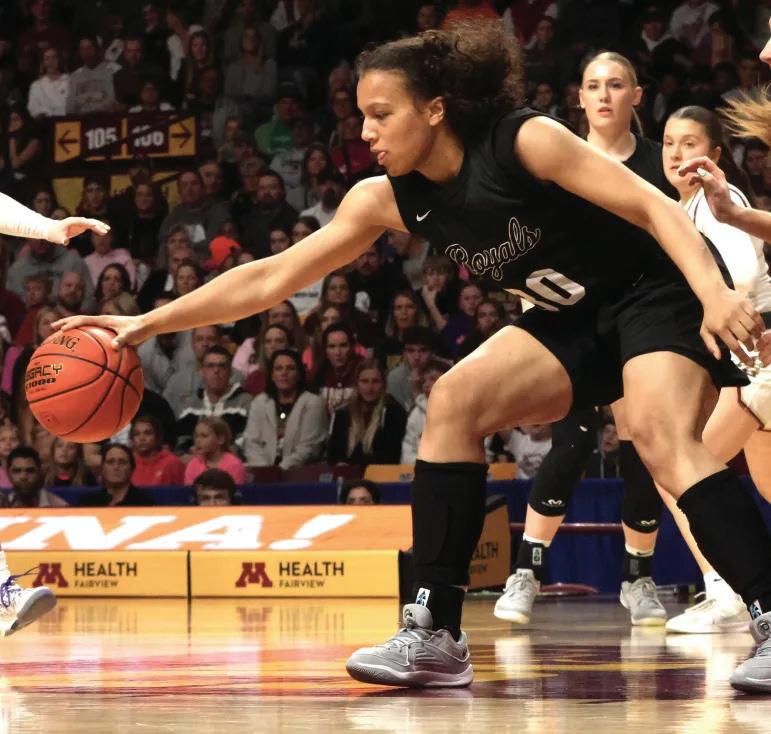

Jellybean Johnson: A legacy of joy and genius
National boycott brings Target ‘to its knees’
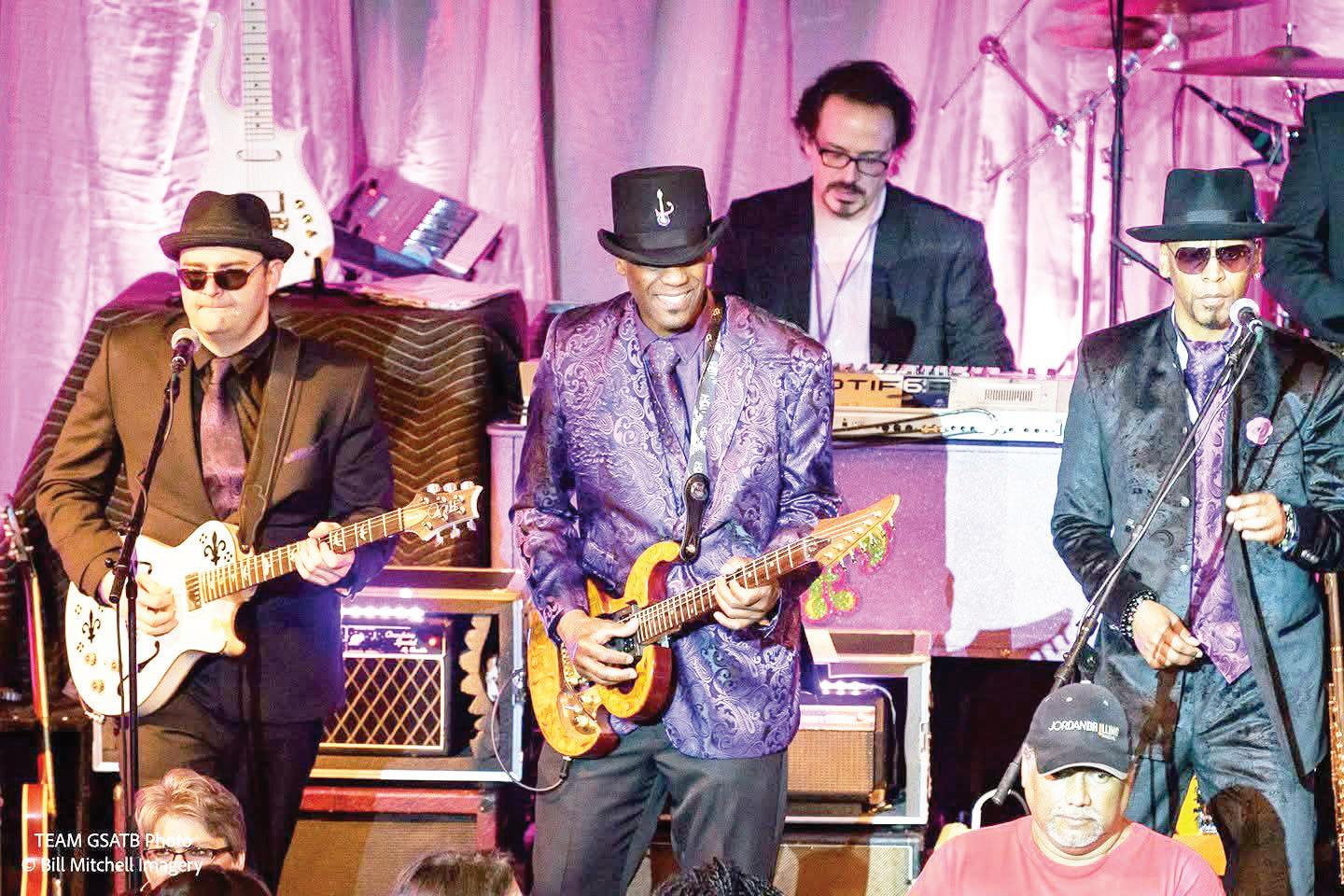
By Scott Selmer Assigning Editor
n stage, Jellybean Johnson was thunder and electricity. Behind the drum kit, behind the guitar, and behind the curtain of Minneapolis fame, he was a force so steady and full of joy that even those who played beside him for 50 years still struggle to believe he’s gone.
But for his daughter, Bianca Rhodes, the first image that flashes is simpler: a towering man in a long coat stepping into her North Side daycare, arms outstretched. “‘Daddy’s big baby, how’s that baby?’” he would say, scooping her up. “I’ll never forget that,” she said.
“His hugs, his kisses, his joy. That’s what comes first.” Johnson: drummer, guitarist, producer, and an architect of the Minneapolis Sound, died suddenly Nov. 21, two days after his birthday, sending shockwaves through a community that has long regarded him as one of its brightest cultural pillars. His loss has left Minnesota’s musical elders grieving, young musicians reflective, and his family determined to protect his legacy. And across the Twin Cities, the stories pouring out reveal a man who lived his life tuned to one frequency: connection.
“Bean was the same person wherever you saw him,” said Gary Hines, bandleader of Sounds of Blackness. “Whether
it was the Grammys, Bunkers or on the street… positive, encouraging, hilarious. His stage persona was just an amplification of who he already was.” Hines learned of his passing the same day the two traded their usual affectionate texts.
“We always said, ‘I love you.’ I’m so glad we said it that day,” he said. “What comes from the heart reaches the heart, and Bean’s heart was enormous.”
To many in Minneapolis, Johnson was the connective tissue between musical generations. He could be at Flyte Tyme [the Minneapolis funk band Harris and Johnson were a part of] one night, mentoring high-school players the next, then dropping in at Minnesota
■ See JELLYBEAN on page 5
MPD accused of hiding lethal incompetence
Three residents of color called for help. Only one survived.
By Clint Combs Contributing Writer
avis Moturi is alive to tell his story. Allison Lussier, an Indigenous woman, and Mariah Samuels, a Black woman, are not.
The pattern is tragically familiar: people of color repeatedly calling 911, warning police about violent neighbors or ex-partners, doing everything authorities ask, only to be met with inaction. Lussier and Samuels were killed this year despite those warnings.
ing signs that advocates say contributed to the deaths of Lussier and Samuels.
Repeated warnings answered
On Oct. 23, 2024, Moturi was trimming a tree outside his home on Grand Avenue So. when he suddenly felt a surge of pressure in his chest. He thought he was having a heart attack. Doctors discovered he had been shot in the neck. The alleged shooter was his next-door neighbor, 54-yearold John Sawchak, a White
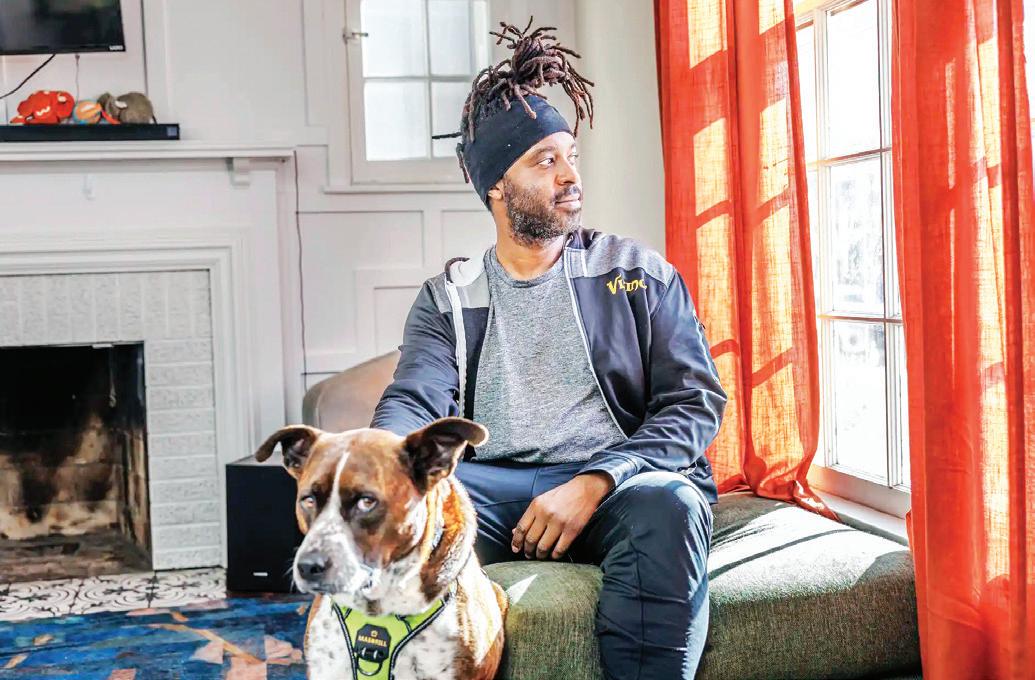
Moturi survived a gunshot to the neck last October. His case is now raising serious questions about whether the Minneapolis Police Department ignored the same warn-
man whose history includes multiple harassment allegations and criminal convictions. According to court records and neighbors, Sawchak has been the subject of at least
10 restraining orders over the years.
Moturi and his wife, Caroline, who moved in during fall 2023, say they called police at least 29 times in the year before the shooting. “We are living in constant fear of John,” Moturi wrote in an April restraining-order petition. He said Sawchak frequently told him to “go back to North Minneapolis.”
A Black family who lived in the same home before the Moturis told them Sawchak’s harassment pushed them to move. The family has since confirmed this to the MSR.
But what Moturi didn’t know was the most devastating: Sawchak had an active felony warrant for his arrest that police never executed.
A warrant ignored Hennepin County Attorney Mary Moriarty told the MSR that her office charged Sawchak with felony threats of violence on July 10, 2024. “Mr. Sawchak was not arrested on that warrant and remained in the community until he shot Mr. Moturi on Oct. 23, 2024,” Moriarty wrote.
Moturi discovered the warrant only because he refused to stop asking questions. “I called 20 people,” he said.
■ See MOTURI on page 5
Minnesotans urged to shop elsewhere through holidays
By Jasmine McBride Editor
ivil rights leaders gathered in Minneapolis on Nov. 20, days before the busy
cuts in an effort to recover weakened sales and falling consumer sentiment.
The coalition, led by the Racial Justice Network, CAIRMinnesota, Unidos Minnesota, and original organizers of the
inauguration committee.
Target, which has long marketed itself as a Minnesotabased brand aligned with community values, has experienced notable financial turbulence this year. In the months
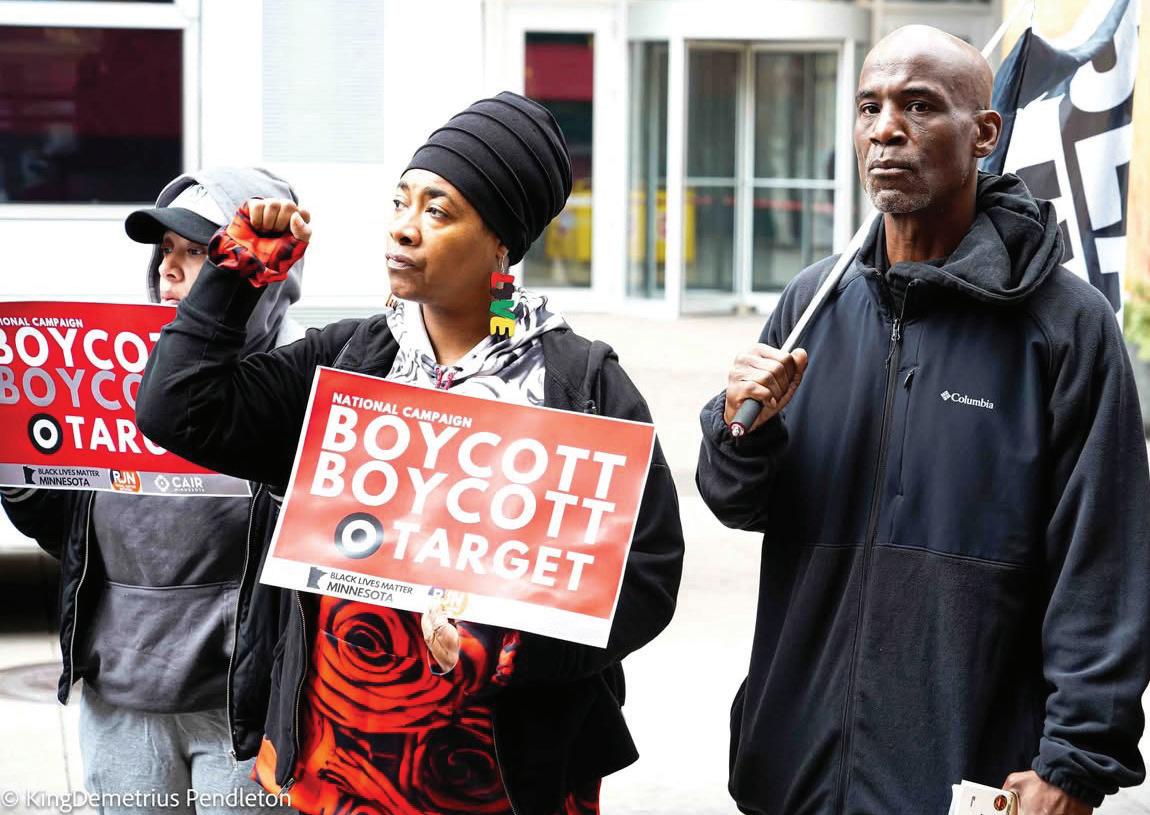
holiday shopping season, urging Americans to “hold the line” on a months-long nationwide boycott of Target. Speakers emphasized that the timing of the press conference was intentional, coming as Target rolls out deep seasonal discounts and aggressive price
Target Boycott, reiterated their call for shoppers to avoid Target through Black Friday and the holidays, saying the company “capitulated” to former President Donald Trump by rolling back its diversity, equity and inclusion initiatives and donating $1 million to his
following the February launch of the boycott, Target’s stock price fell sharply and traffic numbers declined nationwide. The company recently announced thousands of corporate layoffs and replaced its CEO amid continued pressure
■ See TARGET on page 5
High-profile names blacked out in Epstein files

By Stacy M. Brown
he fight over the Epstein files reached a boiling point Nov. 18 as Congress moved to force their release, but the real story has already unfolded behind closed doors. The documents were scrubbed long before lawmakers ever approached the floor. What should have been a moment of transparency has become a demonstration of how political power shields itself while the public is told to wait.
“Once the House passes the bill to release the Epstein files today, I will move for the Senate to immediately take it up and pass it,” stated Sen. Chuck Schumer of New York, the Senate Democratic leader. He added that “Republicans have spent months trying to protect Donald Trump and hide what’s
in the files.” He said the American people want the truth.
According to Bloomberg News, Donald Trump’s name appears throughout the Epstein materials. What has not been widely reported is that an FBI FOIA review team blacked out Trump’s name and the names of other high-profile figures. Three people familiar with the review process said the redactions were completed before the Justice Department and FBI declared that no further disclosure would be appropriate or warranted.
“The only reason the House is voting today is because the Trump administration is refusing to comply with a subpoena,” Rep. Kelly Morrison of Minnesota, a Democrat, stated. She said the president and his administration “are legally required to release the files to Congress,”
adding that leaders have “been complicit in covering up the horrific abuses of Jeffrey Epstein and Ghislaine Maxwell.”
Inside the FBI, the work stretched across two facilities in Winchester, Virginia. Director Kash Patel ordered agents from the New York and Washington field offices to join FOIA employees and review every Epstein-related document. Nearly 1,000 staff worked through the night to process grand jury testimony, prosecutors’ materials, and decades of investigative files. Not everyone agreed with how the review unfolded. Michael Seidel, section chief of the Record and Information Dissemination Section, objected to the directives. Patel blamed him for delays in getting records to Special ■ See EPSTEIN on page 5
Metro
Target’s DE&I pullback leaves Black local suppliers in limbo
By Scott Selmer Assigning Editor
Twin Cities Black entrepreneurs who once benefitted from Target’s diversity, equity and inclusion commitments now face a shifting landscape.
When Target pledged billions toward racial equity and diverse supplier programs following George Floyd’s murder, Black-owned brands in Minnesota saw an opening that had long been closed. From expanded shelf space and mentorship to national distribution deals and marketing support, the Minneapolis-based retailer positioned itself as a corporate anchor in the push to build generational wealth in communities historically shut out of the retail economy.
But now, with Target retreating from DE&I goals, some local entrepreneurs say the momentum that once promised growth and stability has faded, raising questions about whether progress for Black-owned businesses was a long-term strategy or a temporary cultural moment.
Under Target’s REACH initiative, Black-owned brands experienced unprecedented opportunities: product placement in hundreds of stores, supply-chain contracts, increased staffing and revenue streams that depended not just on local sales, but national distribution. Analysts say the supplier-diversity commitment helped these businesses achieve national shelf access, distribution opportunities, and
marketing support. Among the beneficiaries were Minneapolis-based The Get Down Coffee Co. and Houston White’s lifestyle and grooming lines. While some of Houston White’s products remain available on Target’s website, The Get Down Coffee Co. has temporarily closed, posting a notice in its Camden Neighborhood location announcing plans to reopen in spring 2026.
Minneapolis and St. Paul’s Frogtown — appear to have been fragile. When Target wound down its three-year DE&I commitments, reduced diversity reporting, and repositioned its equity branding, some Black business partners say the pace of partnership opportunities slowed.
Access to a retailer like Target can reshape a company’s financial trajectory. National purchase orders allow entre-
effects ripple outward: fewer jobs, fewer contracts for other local companies and slower wealth-building in the community. In Minnesota, where disparities already define business ownership and median household income, the retreat may widen gaps rather than close them.
Economic uncertainty also affects workers tied to Blackowned product lines. Production staff, packaging teams,
duced hours can follow.
The ripple effects extend to community institutions that relied on corporate partnerships, sponsorships, and programs tied to DE&I commitments.
Nonprofits that collaborated with Target on events, incubators, or vendor fairs report that these opportunities have become less consistent, with fewer dollars linked to racialequity outcomes.
Target remains one of Minnesota’s largest employers and most visible corporate citizens.
Analysts say the company’s retreat from equity initiatives places it at a crossroads: maintain an identity rooted in inclusion, or reposition as a neutral

The gains, though real in some ways — creating jobs, increasing manufacturing demand, fostering partnerships and circulating economic activity within predominantly Black corridors such as North
preneurs to hire staff, lease production space, buy raw materials in bulk, and access financing that requires predictable revenue streams.
When Black businesses lose these opportunities, the
delivery drivers, graphic designers, photographers, accountants and communitybased marketing specialists all depend on contracts with national retailers. If those contracts shrink, layoffs and re-
player in a polarized retail environment. Data shows that consumers, particularly Black and other inclusive-minded shoppers, expect brands to operate with values. Reducing diversity efforts risks eroding
trust, brand loyalty and foot traffic, while triggering backlash or boycotts. As the Twin Cities continue to confront racial inequity in business, housing, wealth, and access to capital, the role of major corporations in supporting, or stalling, progress remains pivotal. Target’s pullback may relieve political pressure, but for many Black-owned businesses, the cost is already visible.
Target’s pullback may relieve political pressure, but for many Black-owned businesses the cost is already visible.
For those that invested deeply in Target’s DE&I commitments, keeping that doorway open now feels precarious. Some local entrepreneurs, however, navigated these challenges differently.
A St. Paul beauty and cosmetics business owner said she had avoided aligning with Target to retain full control of her business and profits. Her doors remain open, illustrating that cautious strategies may sometimes shield businesses from sudden shifts in corporate priorities.
Scott Selmer welcomes reader responses at sselmer@ spokesmam-recorder.com.
cessive force.”
By Clint Combs
Contributing Writer
It has become increasingly difficult for residents to determine who is operating federal raids under the Trump administration, as agents often wear masks, lack name plates, and use generic “POLICE” markings on their gear. That confusion was on full display Nov. 18 when federal agents raided Bro-Tex, an industrial paper products manufacturer at 800 N. Hampden Ave. in St. Paul, detaining multiple workers and drawing a swift public outcry.
For workers and nearby residents, the chaos began suddenly. Alejandra Villagrana and Erik Alacorn rushed to the scene after hearing that relatives employed at Bro-Tex had been detained.
“I was at work. My uncle was also one of the ones that were
taken,” Villagrana told WCCOTV, adding that he works two jobs to support their family.
the purpose of the raid or the number of individuals taken into custody, adding to the confusion.
“If working in this country is a crime, then God forbid these people are criminals,” Alacorn told the Star Tribune. “But everyone here has worked for more than 20 years.”
Federal authorities later confirmed that the raid was carried out by Homeland Security Investigations, a division of Immigration and Customs Enforcement, with assistance from FBI and Drug Enforcement Administration personnel. The operation escalated quickly as protesters arrived, and witnesses reported agents firing pepper balls and using chemical irritants on some demonstrators.
Estimates of how many workers were detained vary widely. Federal agencies have released few details about
Alacorn said his mother, who began working at Bro-Tex in 1999, was among those terrified by the events. “This is her first job,” he said.
Masked agents wearing tactical vests labeled only “POLICE” moved across the property throughout the morning. St. Paul officials stressed repeatedly that city officers were not involved.
“It’s really unfortunate, because we work hard to make sure folks know that our St. Paul police officers will never be ICE agents,” Mayor Melvin Carter said.
Mayor-elect Kaholy Her said she received no advance notice of the operation and spent the morning trying to confirm who was on the ground. “You know, the federal agents were wearing gear labeled as police, which is not standard issue for our St. Paul Police Department,” Her said.
“When federal agents mislabel themselves, it creates confusion, undermines trust, and rais-
es fundamental questions about who those officers really are.” Civil rights observers with COPAL were among the first to arrive. Ryan Perez, the group’s director, said they began receiving reports around 9 a.m. from Newell Park, where agents appeared to be staging.
demned the use of masked, unidentified agents. “We need lawmakers to defend Minnesota’s communities,” said Madeline Lohman of The Advocates for Human Rights. “We do not want to live in communities where public safety has been thrown away in order to terrorize our immigrant neighbors.”
Deepinder Singh Mayell, executive director of the ACLU of Minnesota, said constitutional protections apply regardless of

“People start shouting, ‘It’s ICE,’ ‘It’s police,’ ‘It’s FBI,’ and it’s intentionally very confusing,” Perez said. He said observers photographed ICE agents in uniform and described one call from a young resident whose father and uncle were “forcefully zip-tied and removed.” Advocacy groups con-
which agency is conducting an operation. “It does not matter what uniform you wear … Every person has rights,” Mayell said.
“We have the right to free speech, we have the right to assemble, we have the right to due process, and we have the right to be free from ex-
Residents described both physical and emotional injuries in the aftermath. “It looked brutal,” said Isabella Cornelius, who saw several people receiving medical attention.
Lindsay Hansen, who works nearby, said arriving at the scene was “soul-crushing.” “It very much feels like they’re targeting brown people,” Hansen said. “I’ve worked down the street for six years … I’ve never felt unsafe until now.”
Local elected officials pledged to respond. St. Paul City Council Vice President Hwa Jeong Kim said she plans to introduce budget amendments to restore funding for naturalization services and the city’s immigration defense fund.
“We deserve safety, dignity, and the freedom to work and live and breathe without fear,” Kim said.
State Sen. Zaynab Mohammed was more blunt: “What we witnessed here yesterday is what an authoritarian government looks like.”
When on the campaign trail, President Donald Trump framed his proposed massdeportation plans as necessary to protect job opportunities for Black Americans, claiming migrants are “taking Black jobs.” Meanwhile, unemployment among Black Minnesotans rose to 7.7% this year, up from 5.2% last year. Nationally, unemployment among Black Americans increased to 7.5%, up from 6% the year before. Federal agencies did not respond to requests for further details about the Bro-Tex operation.
Future of George Floyd Square still in doubt
By Jon Collins
A last-ditch effort could possibly revive a stalled plan to redevelop the intersection where George Floyd was killed by Minneapolis police officers in 2020. Minneapolis City Council members voted Nov. 20 to add a plan to the final Dec. 11 meeting agenda of the current council that would restore mixed-use access to the intersection.
The intersection of 38th Street and Chicago Avenue, now known as George Floyd Square, was occupied by protesters and closed to traffic shortly after Floyd’s killing. Although car traffic now proceeds through stop signs and around a traffic circle, the City Council has struggled to align on a shared vision of the development.
The City Council previously worked with staff to develop a “mixed-use” plan that council members tabled in February, which would have reopened the intersection to bus traffic and included a number of features like bikeways and wider sidewalks.
City staff didn’t include an analysis of a pedestrian mall on the site because they said it wasn’t feasible. That spurred Council Member Jason Chavez, whose district includes a portion of the intersection, to propose a pedestrian mall study; the council ultimately overturned a mayoral veto of that provision.
The report on a pedestrian mall, which does not include a specific layout, will be presented to a City Council committee
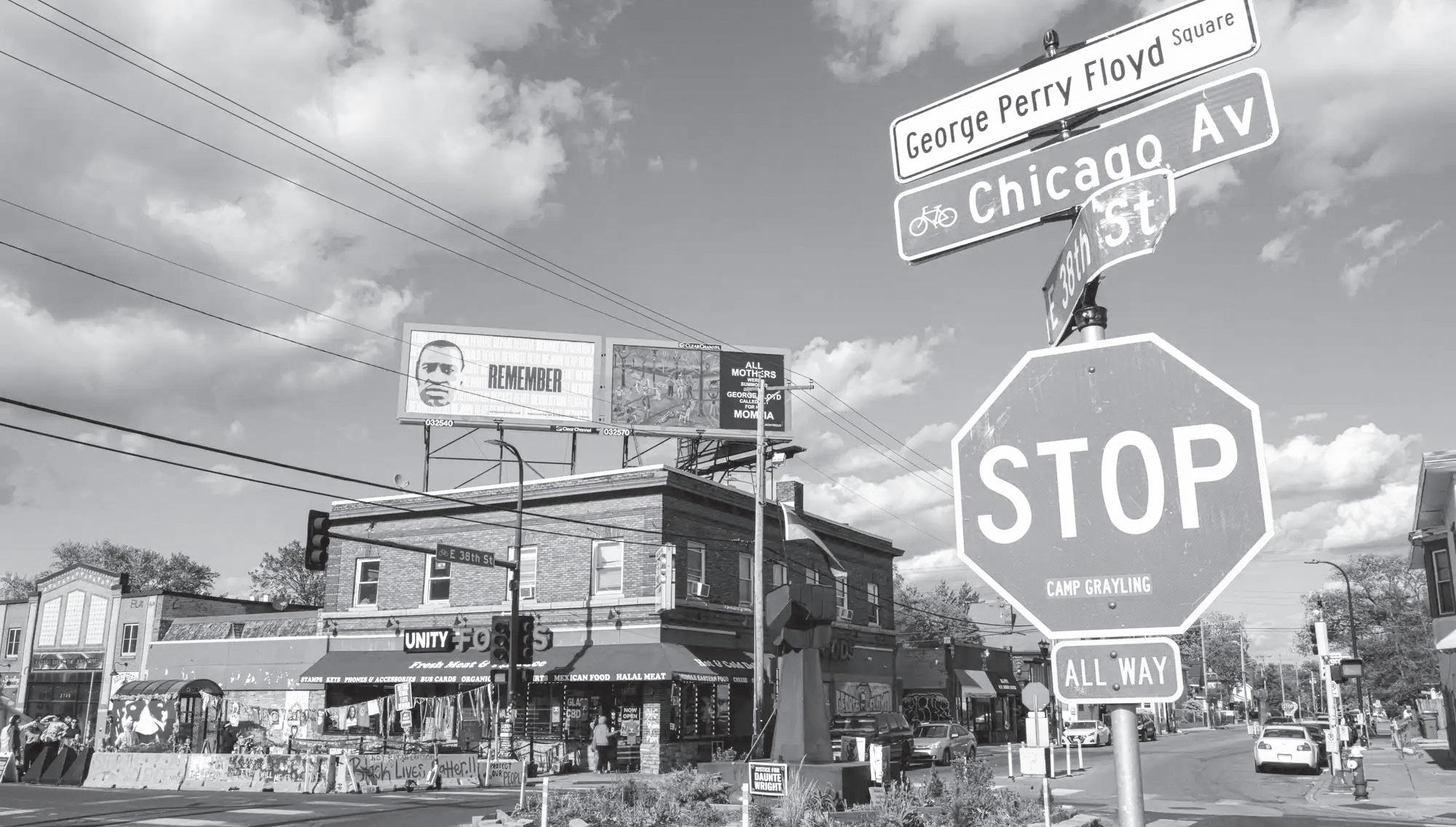
in the first week of December, just a week before their final meeting this term. A community group will also release a plan ahead of that final meeting.
More than five years after Floyd was killed, council members have expressed some urgency about resolving the issue of what happens to the intersection.
Council Member Andrea Jenkins, whose district also includes a portion of the intersection, said at Thursday’s council meeting that she wanted to put the concept proposed by city staff back on the table to prevent yet another delay of the reconstruction. Jenkins said her action “would only provide us with an opportunity to consider this option if the pedestrian mall option is not a viable solution.” Chavez strongly supports
a pedestrian option and cited his vote total at one precinct close to the intersection as a mandate from voters to deliver it. He also noted that State Sen. Omar Fateh, who supported that option, won handily against incumbent Jacob Frey in the neighborhoods around the square in this month’s mayoral race. Chavez opposed Jenkins’ motion but said he’s “ready to find a compromise.”
Jenkins countered that “there are three other neighborhoods that are at that intersection, and they did not vote for you, sir. It would be a disservice to the entire community to have one precinct determine the outcome for the entire intersection.”
Council Member Aurin Chowdhury said she was “frustrated and confused” about what the city’s vision is for the street: “I
really am asking for leadership across the board from everyone, to lean in and figure out what’s our path forward.”
About 70% of people who responded to an online survey administered by the University of Minnesota’s Center for Urban
“Not supporting this
option
to take a vote on this at the end of this term means continued delay on the revival of George Floyd Square.”
Council Member Robin Wonsley said it’s important that the “community is in the driver’s seat” and not the city, which she said was ultimately responsible for Floyd’s death.
The city has been gathering input from residents on the future of the site since 2021.
Effect of state consent decree on MPD still unknown
By Clint Combs Contributing Writers
Legal experts, civil rights officials, and Minneapolis police reform leaders said Thursday that it’s still too soon to know whether the state’s consent decree is changing the culture that allowed racism and abuse to persist within the Minneapolis Police Department. The comments came during a Nov. 20 panel at The Glass House.
“The answer is we don’t know yet,” said Minnesota Department of Human Rights Commissioner Rebecca Lucero.
The panel featured Lucero; GaneishaEff Martin, chief of MPD’s Constitutional Policing Bureau and one of the first civilians to hold a high-ranking role within the department; and Arlinda Westbrook of Effective Law Enforcement for All (ELEFA), the independent monitoring team overseeing MPD’s compliance with the agreement.
Martin said MPD needs significant technology upgrades to track reforms and share real-time information with the public, improvements she said remain difficult to fund due to resistance toward increasing the police budget.
“There’s not technology where you can automatically put it in and it has analytics,” she said. “I’m in the process of trying to hire the right people who can do that type of work in the police department, which is a whole situation.”
Transparency, she added, depends on tools the department simply does not yet have.
“You can’t be transparent to the community, and you can’t properly manage your standards and try to create cultural change, if you don’t have the technology.”
ficer Derek Chauvin knelt on George Floyd’s neck for more than nine minutes on May 25, 2020. MDHR found a decadelong pattern of racial discrimination and unconstitutional
A separate federal investigation reached similar conclusions, and the U.S. Department of Justice initially sought a federal consent decree. But in June 2025, the DOJ un-
and Regional Affairs in 2023 said they wanted the streets to remain fully accessible to all forms of transportation.
Council Member Linea Palmisano said insisting on a pedestrian mall was a waste of taxpayer dollars and ignored community input that
put, both MPD and ELEFA could strengthen how they respond to community comments, especially by making clear which suggestions are accepted and which are not.
“That doesn’t require a system,” she said.
Last summer, community advocate Mara Schanfield urged MPD and ELEFA to extend public comment periods, arguing that 30 days was insuf-
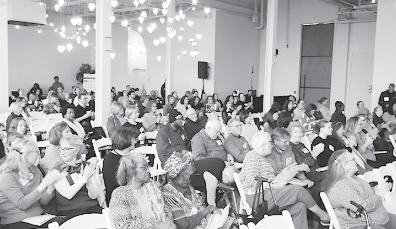
How Minnesota got here
The Minnesota Department of Human Rights (MDHR) launched a sweeping investigation after former MPD of-
policing. The findings led the state to negotiate a courtenforceable consent decree intended to reform MPD practices.
“You can do constitutional policing in a race-based way.”
der President Donald Trump moved to dismiss its lawsuit. However, the state consent decree remains in effect, overseen by MDHR and monitored by ELEFA.
Who shapes reform
The discussion grew tense at moments as panelists weighed in on how the public should participate in revising MPD policies.
Westbrook said that while the decree calls for public in-
had been gathered.
“Not supporting this option to take a vote on this at the end of this term means continued delay on George Floyd Square development, continued delay on the revival of George Floyd Square,” Palmisano said. “It is an important issue to everyone in our city.” Minneapolis City Clerk Casey Carl said embracing the pedestrian mall plan would require council members to restart the process of crafting an ordinance next year when the new council is seated. If the mixed-use layout fails, the council will also be forced to start that process again.
To further complicate matters, city staff are still trying to decide which organization to put in charge of the redevelopment of the former gas station on the site, which is known as The People’s Way.
Council Members Andrea Jenkins, Linea Palmisano, Aurin Chowdhury, Katie Cashman, Jamal Osman, Michael Rainville, LaTrisha Vetaw and Emily Koski voted to add the mixed-use plan to the Dec. 11 meeting’s agenda. Council Members Jason Chavez, Robin Wonsley, Aisha Chughtai, Jeremiah Ellison and Elliott Payne voted against the motion.
This story comes to you from Sahan Journal, a nonprofit newsroom dedicated to covering Minnesota’s immigrants and communities of color. Sign up for a free newsletter at www. sahanjournal.com/newsletter to receive Sahan’s stories in your inbox. For more information, visit www.sahanjournal.com.
cree,’” she said, drawing laughs from the audience.
“There is one guy who is writing policy, reviewing it, doing best practices, and taking in all those lovely comments, trying to translate them. And so we do need a system to help us be transparent, unless we get more money to hire more people.”
Public awareness still limited Lucero urged ELEFA and MPD to take the consent decree process back into the courtroom through public hearings. “People should be able to provide their feedback and comments too,” she said.
Martin said even cities years into their decrees face major challenges with public engagement.
“Seven or eight years into consent decrees in other cities, a lot of people still don’t know about them,” she said. “People either don’t trust it, don’t believe it, or don’t feel safe.”
Westbrook argued that the state-led approach in Minnesota could prove stronger than the federal model, which she said has often faltered once federal oversight ends.
“What was exciting here is that it was led by community who came to the commissioner at the state level,” she said.
ficient for meaningful engagement. ELEFA cofounder David Douglas responded at the time that the 45-day requirement applies only to four core areas under the MDHR agreement, and that the monitoring team’s authority to change the timeline is limited.
Martin pushed back on the suggestion that no additional infrastructure was needed.
“Respectfully, Miss Monitor, this may change to ‘The Real Housewives of Consent De-
“There’s already a community–state partnership.”
Lucero emphasized that constitutional compliance should be seen only as a baseline. “You can do constitutional policing in a race-based way,” she said. Real culture change, she added, requires confronting racial bias directly and moving beyond the minimum legal thresholds.
Clint Combs welcomes reader responses at combs0284@ gmail.com.
policy shifts in Medicaid insurance coverage
Sponsored by

Don’t be caught without insurance if you or your loved ones have a medical emergency and need care right away – policy changes can happen unexpectedly.
Federal cuts will be coming to Medicaid. Nothing has changed yet, but it’s important to learn the facts and be ready.
The federal changes will make it harder to get and keep Medicaid health insurance –also known as Medical Assistance in Minnesota.
One of the most important things you can do is make sure you and your loved ones have health insurance now.
Speak with your navigator to find out if you are eligible for Medicaid and sign up today.
Getting and staying insured is your strongest protection against staying out of medical debt. Don’t wait until you have an emergency.
Visit the Minnesota Department of Human Services’ federal changes website at mn.gov/ dhs/federalchanges/ to learn the facts about the changes coming to Medicaid. The department will be your trusted guide on these coming changes.
Here’s what you need to know about the changes:
• Shorter periods of retroactive coverage = more medical debt?
It will become harder to get Medicaid to pay medical bills for care you received before you apply.
For the past 53 years – since 1972 – Medicaid has provided retroactive coverage going back up to three months from

when you apply. If you end up in the hospital or have a health crisis, you’ve still got time to complete the paperwork and get insured.
But starting in January 2027, the federal government will shorten the periods for this retroactive coverage – down to one month for adults ages 2164 without dependent children who don’t get Medicaid based on a disability, and two months for everyone else.
Shorter retroactive coverage can hurt anyone who needs health insurance and qualifies for Medicaid but isn’t signed up yet, especially people who have a medical emergency, find out they have a health condition, experience a mental health issue or get sick. This change will disproportionately fall on Black Minnesotans, who already face some of the steepest income inequality gaps in the state and rely heavily on Medicaid.
• Work reporting requirements = more people eligible for Medicaid losing coverage?
Starting in January 2027, up to 225,000 adults in Minnesota could face new administrative reporting requirements to verify they are working, in school, in a work program or doing community service in order to be eligible for Medicaid. This will affect adults ages 21 to 64 who don’t have dependent children and who don’t get Medicaid based on a disability. People subject to this requirement who don’t meet the administrative reporting requirements or qualify for an exemption can lose their Medicaid benefits, even if they otherwise still qualify. Exemptions include caring for a family member with a disability, receiving substance use disorder treatment, being incarcerated or within 90 days of release from incarceration, being medically frail, and other circumstances.
The work reporting requirement will disproportionately hurt the Black community and cause people who qualify for Medicaid to lose their insur-


ance because of administrative barriers. Most people who have Medicaid are already working, many of them in unstable, part-time or seasonal jobs with low pay.
For example, Marcus is a 37-year-old man who drives for a ride-share app and sometimes picks up restaurant shifts. He gets paid in cash or through apps. Documenting his work activity will be tough because he doesn’t get pay stubs. He also doesn’t own a printer. That means he’s more likely to lose Medicaid – not because
he’s not working enough, but because he can’t meet the requirements. Without insurance that covers insulin for his diabetes, his health will suffer, and it will be harder for him to stay employed.
• More frequent renewals = more people eligible for Medicaid losing coverage?
With these changes coming, what can you do now?
• Stay informed by visiting the federal changes page at mn.gov/dhs/federalchanges/.
• Don’t wait. Enroll in Medical Assistance (Minnesota’s Medicaid program) now if you qualify. Contact a navigator today by visiting https://www. mnsure.org/help/find-assister/ find-assister.jsp.
• Keep your contact information up to date by visiting https:// mn.gov/dhs/mycontactinfo/ so you don’t miss important timesensitive materials.
• Renew Medical Assistance on time so you don’t lose your insurance. Look up your renewal date at https://www.mnrenewallookup.com/.
• If you’re currently enrolled and your renewal is current, there’s nothing else you need to do right now.
• Share your story about Medicaid by visiting the Faces of Medicaid page at https:// mn.gov/dhs/medicaid-matters/ faces-of-medicaid/.

Starting in January 2027, those same adults will have to renew their Medicaid insurance every six months, instead of once a year. More frequent renewals result in eligible enrollees losing their coverage because of administrative burdens – even though they may still qualify for Medicaid.



Music Café later that evening.
“He always showed up,” said James “Jimmy Jam” Harris. “He might play drums at one club, guitar at another. Every night he was out making music or supporting it. He lived and breathed it.”
Harris credits Johnson with altering the entire trajectory of his career. “I brought my drums to join Terry’s [Terry Lewis of Flyte Tyme] band, and Terry said, ‘We already have a drummer… Jellybean.’ So I became a keyboardist because of him. That changed everything.” He laughed remembering Johnson’s dual nature: the quiet, introspective drummer and the
fiery, spotlight-ready guitarist. “He was rock solid and flamboyant at the same time,” he said. “That was Bean.” At home, Rhodes said, her father moved at a different rhythm: three TVs playing at once, blues humming in the background, guitar riffs drifting through the house while he read the newspaper at lightning speed. “Everybody knows Jellybean. Only a few of us know Garry,” she said, referring to his legal name. “He was introverted, relaxed, listening to Parliament or Sly, playing guitar, and watching basketball.”
Her childhood was filled with small, indelible memories: forehead kisses she refused to wipe off; Timberwolves games at the old Flyte Tyme suite; watching him on “Arsenio Hall” and “Saturday Night
Live”; listening to him critique drummers who attempted to play “777-9311” correctly on YouTube. “As I got older, I understood, music was his first love. So I met him where he was,” she said. “If I wanted to spend time with him, I’d go to the clubs, go to rehearsals, be part of his world.”
Johnson’s musical fingerprints are everywhere: The Time’s “Cool,” Janet Jackson’s “Black Cat,” Alexander O’Neal’s “Criticize,” and Mint Condition’s debut album among them. But for those who worked with him, his spirit mattered just as much. “He didn’t just influence the Minneapolis Sound, he embodied it,” Harris said. “He took it international. He helped shape the rock energy, the funk backbone, the precision.”
Hines agreed. “His drum-
ming was the heartbeat of the Minneapolis Sound. His guitar was fire. And his soul held it all together.”
Younger musicians often describe Johnson as a lifeline. “He was a musicians’ musician,” Rhodes said. “He had nephews everywhere, musicians he loved, who called him Uncle Garry.” Hines recalled countless moments of Johnson mentoring in schools, community centers, clubs and rehearsal halls. “He would sit in, advise, and encourage. He made people better,” he said. Harris added that Johnson also advocated fiercely behind the scenes. “You always knew Bean had your back.”
In recent years, Johnson devoted himself to building what he hoped would be a final, lasting contribution: the Minneap-
olis Sound Museum. Conceived as both a cultural archive and a forward-facing hub for young artists, the space will include rehearsal rooms, classrooms, a soundstage and community gathering areas. Rhodes, who serves as vice president of the board, said the idea took root after the family lost a musician close to them to suicide. “We realized: how does Minneapolis not have this?” she said. “This is music that changed the world.” What she wants people to remember, she said, is her father’s joy and his shredding. “His solos are legendary,” she said. “He could go until the ancestors told him to stop.” She hopes fans celebrate rather than mourn: “Daddy wouldn’t want us sad. He’d want us dancing. Make a playlist… The Time, Janet, Mint Condition,
and enjoy yourself.”
Hines echoed that message.
“His love for this community was fierce,” he said. “His spirit is still here.” Harris summed it up simply: “He was just a good guy. A great guy. And his influence will ripple out for generations.”
Rhodes believes her father prepared her for this moment, even if neither fully understood it at the time. “The body stays, but the energy never dies,” she said. “Daddy did what he needed to do. He left his legacy in place. And he’s still with us.”
And she knows exactly what he would say now: “He’d want you to dance, be happy, and shake your booty.”
Scott Selmer welcomes reader responses at sselmer@spokesman-recorder.com
from investors. Analysts say Target has leaned heavily into slashed prices ahead of Black Friday to pull back customers, a strategy community leaders say underscores the boycott’s impact.
“Do not be fooled by the sticker prices,” said CAIR-Minnesota executive director Jaylani Hussein. “Target is on its knees. This is the moment corporations go from red to black, and they’re hoping holiday sales will rescue them. We’re asking Minnesotans to stand firm.”
Speakers also referenced national data showing how critical the holiday quarter is for Target’s bottom line: Nearly one-third of Target’s annual revenue is generated between mid-November and December, and the retailer depends heavily on its loyal Midwest
consumer base. In Minnesota alone, Target still commands one of the largest shares of household spending, particularly among Black, immigrant, and working-class families, the very communities organizers say have been “betrayed.”
Nekima Levy Armstrong, founder of the Racial Justice Network, reminded attendees that Target publicly pledged $2.1 billion after the murder of George Floyd, promising to improve the Black guest shopping experience, expand Black vendor partnerships, and strengthen internal equity practices.
“They positioned themselves as a national leader when it was convenient,” Levy Armstrong said. “The moment they had a chance to roll back their commitments, they did.”
Leaders also tied their demands to rising fear among immigrant communities following a series of recent ICE enforcement actions in Minnesota. Unidos Minnesota
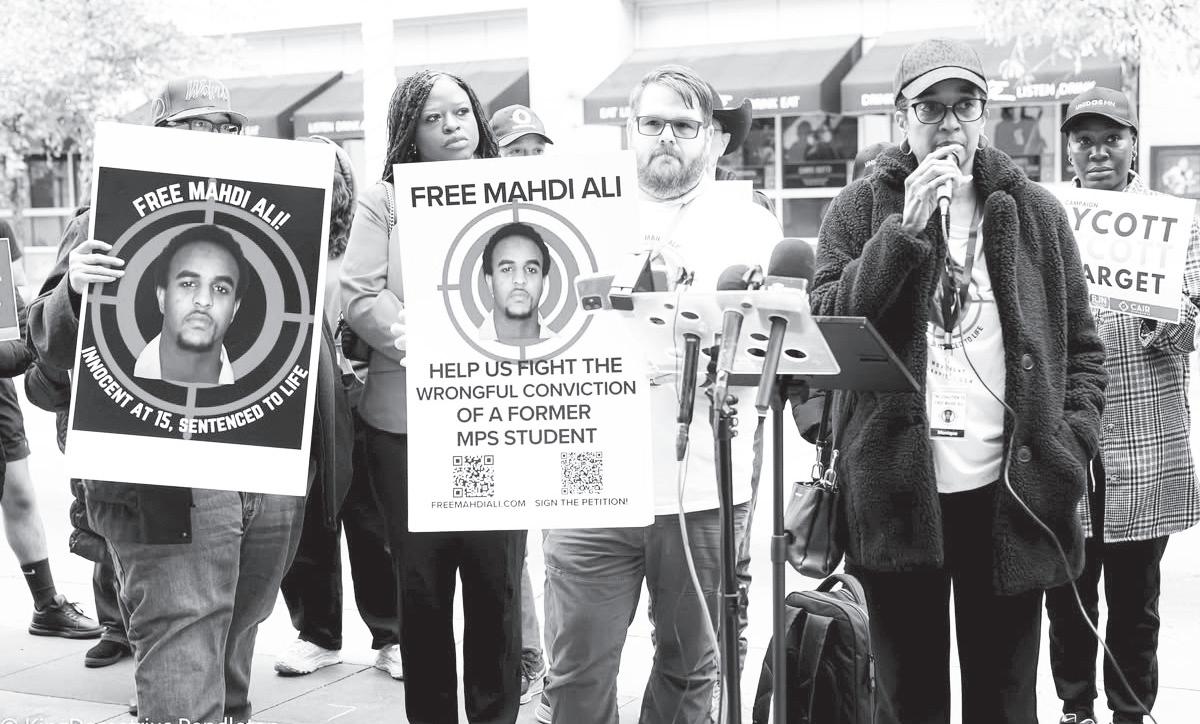
architects of the boycott, emphasized that DEI is not abstract corporate language; it is civil rights work. “Rolling back DEI affirms that some people are not valued,” she said.
“Target promised equity after George Floyd. Now they are walking it back. That’s why we’re here, and why we’re continuing the national boycott rooted right here in Minnesota.”
practices in Hennepin County.
As Minnesotans head into the busiest shopping week of the year, leaders urged families to direct their holiday spending elsewhere, even as Target ramps up major discounts to win back market share. “This is one of the most successful boycotts in modern U.S. history,” Levy Armstrong said. “And it started right here.”
“Target promised equity after George Floyd. Now they are walking it back.”
“Somebody in Hennepin County was like, ‘I’m not supposed to tell you this, but he actually has a warrant for his arrest.’ I was like, wow. Because I had called the cops so many times and there were zero charges.”
He said police never told him about the warrant, not even after he reported Sawchak pointing a gun at him two weeks before the shooting. “They didn’t even send the case up,” Moturi said.
He added that several crimes he reported never appeared on MPD’s public dashboards: “I didn’t see any of the crimes that I reported.”
Agencies point fingers
Internal emails obtained by reporters show MPD and the Hennepin County Attorney’s Office scrambling to assign blame after the shooting.
In one message to his chief of staff, Police Chief Brian O’Hara wrote, “The level of
Continued from page 1
Counsel Pam Bondi. Seidel was told he could retire or be fired. He chose to retire.
“President Trump has the power to release the files today,” Rep. Robert Garcia of California, a Democrat, stated. He said millions of survivors of sexual abuse are watching to see whether leaders in the United States will confront powerful abusers. He added that survivors believe
organizer Luis Argetta urged Target to “choose the people,” condemning the corporation for what he called “silence in the face of terror” as undocumented families experience workplace raids and arrests.
“We’re not asking Target to be a political soldier,” Argetta

incompetence here is unreal. I never get correct information.”
When KSTP began investigating the case, O’Hara added, “Multiple complaints have been filed??? This is nothing like what I was told.” Moriarty, in an email to City Council Member Andrea Jenkins, wrote: “We were told that MPD does not intend to execute the warrant to arrest Mr. Sawchak for reasons of officer safety.”
answers “can be found in the bank records of abusers,” and he warned financial institutions that “if they are hiding records, then we will be coming after them.”
According to Bloomberg News, the FOIA team used privacy exemptions to justify blacking out Trump’s name and others. Because Trump was a private citizen when the Epstein investigation began in 2006, his name was withheld under rules meant to shield private individuals from embarrassment.
“We have a little more work
O’Hara disputed that characterization, saying MPD made “over 20 specific attempts” to arrest Sawchak but could not “lawfully execute the warrant.” He accused Moriarty’s office of continuing “a long pattern of spreading misinformation.”
Neither agency has fully explained why a man with 10 restraining orders, documented threats, and an active felony warrant remained free
ahead of us, but my hope is Leader Thune will do the right thing,” Sen. Mark Kelly of Arizona, a Democrat, stated, referring to Senate Majority Leader John Thune of South Dakota, the top Republican in the chamber.
Fractures are appearing even inside Trump’s own party. “Trump called me a traitor for supporting Epstein survivors,” Rep. Marjorie Taylor Greene of Georgia, a Republican, stated. She accused the president of tearing apart his own movement by refusing to
said. “We’re asking them to stand with the people who power their profits, the workers stocking shelves at 4 a.m., the parents stretching every dollar, the immigrants who harvest the food that Target sells.”
Monique Cullars-Doty, cofounder of Black Lives Matter Minnesota and one of the
despite repeated 911 calls.
MPD resistance
The Minneapolis City Auditor’s Office launched an investigation into the handling of Sawchak’s case after the shooting. But City Auditor Robert Timmerman reported unusual resistance from MPD.
Organizers say they will not lift the boycott unless Target reverses its DEI rollback and recommits to the pledges made in 2020. They also announced additional demands related to Target’s history of influencing criminal justice
Target Headquarters failed to respond to MSR for comment, which local advocates say speaks to their lack of concern.
Jasmine McBride welcomes reader responses at jmcbride@ spokesman-recorder.com.
“They’re hiding and dragging their feet because they know they acted incorrectly.”
An investigator who initially agreed to cooperate soon appeared to be coached, Timmerman said. In an email apparently sent after consulting a union representative, an officer asked Timmerman: “Could I be subject to discipline if you believe that any answer I provide is incomplete or untruthful?”
Council President Elliott Payne called the situation “a red alert.”
Council Member Aisha Chughtai said she was “alarmed by what I hear and what I see.”
The audit, originally due in
“We are launching a political movement to expose the systems that protected predators for far too long.”
release the files. The survivors themselves delivered the sharpest mes-
December, has been pushed to February because of MPD’s lack of cooperation. The Auditor’s Office has since allocated $200,000 to an outside firm to complete the investigation. After the November city elections, Assistant Police Chief Katie Blackwell issued a memo instructing all officers to cooperate.
Complicating matters further, Mayor Jacob Frey has proposed significant budget cuts to the Auditor’s Office, an office that reports to the City Council and serves as a key independent oversight body.
Critics say the cuts undermine transparency at a time when public trust is already fragile.
Deadly consequences
Advocates say Moturi’s case mirrors systemic failures that also affected the late Allison Lussier and Mariah
sage. “We are launching a political movement to expose the systems that protected predators for far too long,” survivor Lisa Phillips stated.
Wendy, another survivor, said she and others never asked to be pushed into political warfare and added, “Standing on the right side of history is not a comfortable place to be.”
Sky Roberts, the brother of Virginia Giuffre, cried as he said Epstein trafficked his sister to a network of rich and powerful people. He said his sister made a “monumental
Samuels, both women of color who repeatedly sought police protection before being killed this year. Their families and community leaders say both deaths could have been prevented if authorities had acted on earlier warnings.
Moturi sees the connection, too. “If they’re being apprehensive, it’s because they know what they did was wrong,” he said. “They’re hiding and dragging their feet because they know they acted incorrectly.”
Then he paused and reflected on what still haunts him. “So assuming I didn’t get shot,” he said, “nobody would have known this was happening.”
The next Minneapolis Audit Committee meeting is scheduled for Dec. 8 at 10 a.m. in Room 350 of the Public Service Center, where city leaders are expected to receive updates on the investigation and address questions about MPD’s handling of the case.
Clint Combs welcomes reader responses at combs0284@ gmail.com.
impact” by speaking out.
The names inside the Epstein files belong to some of the most powerful figures in the world. Their presence does not prove criminal conduct. It reveals proximity. And proximity is exactly what many have tried to deny for years.
“Americans are tired of waiting and are demanding to see the truth,” Schumer stated.
Arts & Culture
D’Angelo: Pondering what could have been
By Donna Jacob
The music world is mourning the loss of Michael Eugene Archer, known to millions as D’Angelo. The singer, songwriter, and multi-instrumentalist passed away on Oct. 14 after a long, private battle with pancreatic cancer, leaving fans, peers, and protégés reflecting on his legacy and imagining what more he could have contributed to music.
Ahmir “Questlove” Thompson, drummer for The Roots and a longtime friend of D’Angelo, spoke publicly for the first time on Oct. 30. “Truthfully, I wasn’t ready for that gut punch,” he wrote on Instagram. “I’d been bracing for it for some 25 years since the deluge of ‘Voodoo’ in 2000. I always had a looming feeling concerning D, like, any moment now I would get the call.”
Questlove called D’Angelo “one of the last pure artists in Black music,” noting that many mavericks who “fly that close to the sun never get to see the journey through.”
Born Feb. 11, 1974, in Richmond, Virginia, to Pentecostal preachers Maria and Luther Archer Sr., D’Angelo grew up steeped in religion and gospel music. By age three, he was already demonstrating prodigious talent, learning piano by
ear. At five, he began performing in his father’s choir, eventually becoming the main musician at the Refuge Assembly of Yahweh Church, a role he held until he was 12.
D’Angelo’s professional career began early. At 17, he signed a publishing deal, and two years later, EMI Music brought him on as a recording artist. His first major breakthrough came co-writing “U Will Know” with his older brother, Luther. Featured in the 1994 film “Jason’s Lyric,” the song was performed by Black Men United, a collective including R. Kelly, Usher, Boyz II Men, and Raphael Saadiq, who would remain a key collaborator for D’Angelo over decades.
seven months. “Brown Sugar” combined hip-hop and R&B with raw, classic soul reminiscent of Marvin Gaye, Al Green, and Prince, shaping the template for a generation of artists. Success, however, brought its own challenges. D’Angelo was uncomfortable with fame, struggling to reconcile the performance and celebrity aspects with his creative identity. Cultural critic Michael Gonzales recalled, “Fame is a weird thing. A lot of people want to be famous. But when they become famous, they’re like, ‘oh shit!’”
“What D. did is make music that is just timeless. It stands up. Brown Sugar changed the world of soul music.”
His 1995 debut album, “Brown Sugar,” introduced a fresh sound later labeled “neosoul,” though D’Angelo himself preferred to call it simply Black music. The album’s hits: “Lady,” “Cruisin,” “Higher,” and the title track spent 65 weeks on the Billboard 200, and the record was certified platinum within
In 2000, D’Angelo released “Voodoo,” an album now regarded as a seminal moment in neo-soul. Featuring the hit single “Untitled (How Does It Feel),” the album debuted at No. 1 on the Billboard 200, selling nearly 2 million copies and earning him his first two Grammys. Questlove reflected on touring with D’Angelo in support of “Voodoo:” “It was probably the greatest soul review since prime Prince. Anyone who’s seen it, their lives
were changed.”
Despite the acclaim, D’Angelo withdrew from the public eye for years, battling addiction, depression, and discomfort with his sex-symbol status. Perfectionism and the pressures of expectation made creative work both cathartic and challenging. In 2014, he returned triumphantly with “Black Messiah,” his third studio album, which debuted at No. 5 on the Billboard 200 and No. 1 on the R&B/Hip-Hop charts, earning him two more Grammys. The album fused soul, R&B, funk, and rock while addressing social and political issues affecting the Black community, including the killings of Oscar Grant, Michael Brown, and Eric Garner.
D’Angelo’s influence extended far beyond his own recordings. He collaborated with and mentored numerous artists, including Lauryn Hill, Erykah Badu, Bilal, Anthony Hamilton, and H.E.R. Tyler, the Creator, credited “Voodoo” with shaping his musical DNA as a child. H.E.R. described D’Angelo as “spiritual” and called their conversations and collaborations “a gift of a person.”
His music was rooted in his upbringing, with gospel-tinged songs like “Higher” reminding listeners of the Pentecostal church environment that shaped his early life. D’Angelo
‘Natural Order’ explores love, trauma and renewal
By Sagirah Shahid
Many somewheres across Black America, we gather around dinner tables with kinfolk — because we got the day off; because aunties, uncles and cousins are always reason enough; because someone will inevitably bring the greens, the baked mac and cheese, and the black-eyed peas, and someone else will grumble about politics. There is always that mumbling uncle whose conspiracy theories make you groan but who would hand you $20 for an empty gas tank without hesitation. And after peach cobbler and sweet potato pie, you may still join that same uncle for an impromptu game of dominoes or, “bones,” as so many of us call them.
Donika Kelly understands
the intimacy of that setting.
Her new poetry collection,
“The Natural Order of Things,” opens with keen attention to the cultural and familial weight carried by a simple game of bones. That focus becomes clearest in her recurring series “The Bone Museum,” threaded throughout the book. In the
“‘The Natural Order of Things’ urges us to marvel at how the world’s inherent kinship reverberates back through us, felt, as Kelly would say, deep in our bones.”
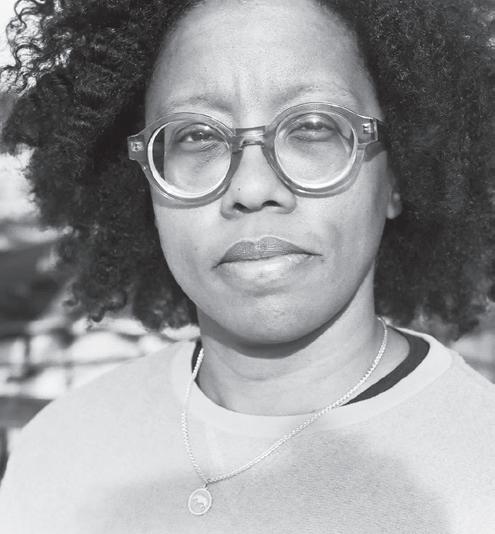
Donika
Kelly Donika Kelly
second poem of the series, Kelly writes:
“...She say she know and run the board/like she playing for the rent/Say and I’m out/slam the bones hard enough to rattle/to wake up the dead.”
In a recent interview, Kelly said she nearly titled the entire collection “The Bone Museum,” a choice that would have made


played multiple instruments, harmonized with himself, and delivered performances imbued with sincerity and spiritual depth.
At the time of his passing, D’Angelo was reportedly working on a fourth studio album with Raphael Saadiq and had planned to headline the Roots Picnic in May 2025, celebrating the 25th anniversary of “Voodoo.” While those events did not come to pass, his enduring body of work continues to inspire. Miles Marshall Lewis, a writer and critic, reflected, “You get saddened to think about the art that we will never hear or receive… It’s a great loss to music.”
Even with his passing, D’Angelo’s influence remains palpable. From the artists he mentored to the genera-
again, this time situated near the center of the erotic section. Its presence invites readers to consider the three books together as a continuum.
tions of musicians inspired by his genre-defying artistry, his legacy is one of innovation, musicality, and authenticity.
“What D. did is make music that is just timeless. It stands up,” Gonzales said. “‘Brown Sugar’ changed the world of soul music.”
D’Angelo’s battles are over, but the streets of gold he sang about in “Higher” resonate with a spiritual authenticity uniquely his own. For fans, fellow artists, and the music community, the gift he leaves behind is immeasurable: a testament to the enduring power of soul, passion, and artistry.
Donna Jacob, a student at Howard University, originally wrote this article for 101Magazine.net, a partner of HUNewsService.com.
sense. Bones, literal, imagined, missing, reimagined, appear throughout the book as a central, multiplying image. Their presence and absence anchor the four sections of the collection, which circle forms of love in the broadest, almost Greek sense: self-love, familial love, erotic and romantic love, and the wider love that binds communities. Across all of them, bones follow.
Kelly is masterful in the ease with which she moves this imagery through the book.
In “Self-Portrait: A Triptych,” bones reappear in the third section, subtitled “Carapace,” the scientific term for the hard outer shell of many small animals:
“And now my tortoise self. My crab self. My tortoise self. My crab self. My heavy and old. My carapace too small.”
Here, Kelly is at her finest. The tortoise’s protective burden and the crab’s confined shell, which must be shed to grow, become metaphors for a body healing from trauma while making space for erotic pleasure. Kelly, a Black queer woman, situates this self-examination among a sequence of lyrical poems exploring queer intimacy and desire. The poems offer an unapologetic celebration of Kelly’s love for her wife.
For readers familiar with her earlier collections, “Bestiary” and “Renunciations,” which address the trauma of her father’s sexual abuse, the use of animal figures as intermediaries between pain and embodiment will feel familiar. In “The Natural Order of Things,” the poem “The moon rose over the bay. I had a lot of feelings.” appears
“I am taken with the hot animal/of my skin, grateful to swing my limbs,” she writes, a line that, in this new placement, reads less like an ending and more like a turning point.

The recontextualized poem signals a shift in Kelly’s concerns. Trauma is not the focus of this collection, though it remains a distant whisper. Instead, “The Natural Order of Things” attends to love as a regenerative force, one inseparable from the body and the natural world. The world, in turn, becomes a compass guiding survivors toward the possibility of what comes after harm.
In “Every moment I have been alive, I have been at the height of my powers,” a crown of interlocking sonnets, Kelly writes:
“Which ever direction I walk is north, cardinal. For years now, I have only walked north. I have walked north into a sun lifting the horizon like a seedling through soil.”
In these poems, movement becomes healing. Walking north becomes an insistence on survival, on wellness, on moving toward the light even when the past lingers.
Justice, in Kelly’s work, is not courtroom-bound but often imagined, a felt desire to
correct everyday violations against Black people in public spaces. In “We Came Here to Get Away From You,” a white woman interrupts the speaker’s quiet moment with an exhibit of whale bones to perform grief over the murder of Emmett Till. The poem ends with a startling line: “...I wanted/to hold her shoulders, vomit into her mouth.” The visceral rejection underscores the exhaustion of racial intrusion. Other politically aware poems, such as “What I Might Sing” and “I never figured out how to get free,” offer similar moments of communal recognition and resistance.
Still, Kelly grounds the collection in love’s perpetual capability. In “Major Arcana,” she writes:
“This weather, unreasonable this longing, yet both–one alongside the other–companions for the day’s practice: a praise song to youth and I love you,”
If Mary Oliver and Audre Lorde had a queer literary descendant, one could imagine her writing poems like Kelly’s. With clarity, lyricism and deep care for the natural world, Kelly invites readers to find themselves in the vastness around them. She writes to the marrow of what it feels like to be human in uncertain times, reminding us to center our loves, our bodies and the reveries that surround us.
“The Natural Order of Things” urges us to marvel at how the world’s inherent kinship reverberates back through us, felt, as Kelly would say, deep in our bones.
Copies of “The Natural Order of Things” are available at www. donikakelly.com.
Sagirah Shahid is an awardwinning poet and was a finalist for the city of Minneapolis’ position of poet laureate. You can find more about Shahid’s writing at www.https://sagirahshahid.com.
Education

By Dr. Artika Tyner
The weather worldwide has become increasingly unpredictable. In the state of Minnesota, we now experience recordhigh temperatures during summer, irregular rainfall patterns, and milder, less reliable winters. These uncertainties are experienced by families through higher cooling bills, which has increased the energy burden on low-income communities. In addition, challenging cold weather conditions require additional heating.
Community-based adaptation refers to locally driven approaches aimed at addressing the impacts of climate change. These actions are carried out by the communities themselves, from the identification of climate issues to the planning and implementation of the solutions. This article offers readers practical ways for families to adapt to the effects of climate change, as well as passing on knowledge to their children by activating their leadership.
The effects of climate change are being felt in realtime in Minnesota. With the changing climate comes much warmer winters, heavier and unpredictable storms, and an increased prevalence of heatwaves to name but a few.
Making a difference: Key strategies for community-based adaptation
These occurrences have led to effects such as flooding in lowlying neighborhoods, a rise in energy bills and damage to homes due to heavy storms. We as a community need to have a better understanding of community-based adaptations. This is the first step in coming up with effective solutions.
Practical family strategies
1. Coping with extreme heat:
a. Planting of trees to help reduce indoor and outdoor temperature.
b. Fans and air-conditioners should be utilized effectively. During hotter days, these sources can serve as tools for cooling. Windows could be used for ventilation during the cooler nights by facilitating natural air circulation.
c. Replace old bulbs with LED lights since they emit less heat.
d. During extremely hot days, visit fountains or cooling centers such as libraries or community centers. These locations usually have air conditioning and proper accommodation.
Teaching moment: In planting trees, children can assist by watering the plants daily. Use this opportunity to educate them on the importance of trees to the existence of life on earth. This helps raise environmental awareness and fosters leadership.
2. Managing flooding and heavy rain:
a. Communal labor drives should be employed to clear gutters. Storm drains with debris

prevent free flow of rainwater and as such should be cleared.
b. Plant rain gardens to absorb water naturally.
c. Children should be educated on emergency readiness during times of floods.
Teaching Moment: Floods will occur; therefore, it is vitally important for families to have safety measures in place. It is imperative to also plan for such emergencies. Children should be made integral pieces of this by undertaking simple but impactful tasks such as knowing basic basement safety protocols like avoiding outlets in the presence of water. Planting native plants in rain gardens also teaches children
that nature itself can be used to protect the environment.
3. Building energy resilience:
a. The use of energy-efficient appliances and lighting cannot be overemphasized, as this reduces electricity use.
b. Using smart thermostats will help regulate energy use.
c. Teach children to switch off lights and unplug devices when not in use.
d. Knowledge of energy assistance programs or weatherization services builds community resilience.
Teaching moment: Children can track the differences in energy use and learn about the savings associated with
Minneapolis schools avoid strike, but staff wages still lag
By Scott Selmer Assigning Editor
Minneapolis educators narrowly avoided a strike after union members voted to ratify a new contract agreement, concluding weeks of tense negotiations that had teachers, families, and school staff preparing for a potential district-wide shutdown.
The agreement, which now awaits school board approval, addresses disputes over wages, staffing, and classroom conditions, but some educators say it falls short of stabilizing schools serving the Black community.
“I am happy that we have come to an agreement,” said Dr. Marcia Wyatt, a licensed teacher and union member.
“There’s so much work that needs to be done, but I’m glad that we have the wins that we have.”
Union leaders say the ratified contract prevents disruptions that could have forced thousands of Minneapolis students out of classrooms.
mate Action and Minnesota GreenStep Cities. These organizations have one goal, and that is to reduce the impact of climate change through effective collaboration. Collaborating to plant trees, clear drains and reducing energy use although being undertaken in individual homes, have resounding results as multiple homes are replicating the same efforts simultaneously. We do not require large budgets and climate change experts to commence a Community-Based Adaptation project. It requires the collective action of like-minded people whose goal is to protect the world that they live in for future generations. There is an African proverb that reminds of this responsibility: “Judge each day, not by the harvest but by the seeds you plant.” This is the approach we should all take in tackling climate change.
energy efficiency. There could be a family challenge where the biggest energy saver gets rewarded. Children can also be tasked with the regulation of smart thermostats in the home. This will build their sense of responsibility and strengthen their problem solving skills. Energy saving is not just about the cost saved but also the efficient sharing of scarce communal resources.
Families as community leaders Households taking action leads to a multiplier effect in their communities. Families can join community organizations such as Minneapolis Cli-
work around that area,” she said. Educators said they ratified the agreement because it included meaningful gains, particularly for adult education teachers, even if systemic

stability matters. “We didn’t want to strike, but we wanted progress,” Wyatt said. While members approved
“Our ESPs are having to work several jobs because they’re not being paid enough to only have one job. Some of them still are going to need a second job. There’s always work to be done.”
ers, education support professionals, or ESPs, remain underpaid despite being essential to student support. “Our ESPs are having to work several jobs because they’re not being paid enough to only have one job,” Wyatt said. “Some of them still are going to need a second job. There’s always work to be done.”
An ESP at a Minneapolis middle school, speaking on condition of anonymity because of employment security concerns, said the modest two percent raise in the new contract does not match the rising cost of living. “Two percent is not enough to make a living with one job,” he said.
“The cost of living is more like six percent.”
The employee said licensed Black teachers are disproportionately scarce in his building, while Black employees are concentrated among support staff roles. “As far as Black teachers, there’s not a lot,” he said. “We’re more the ESPs, the people who take the kids who are struggling and try to make the best of what we have.” He added that the strength of the school lies in its support staff.
Wyatt said staffing shortages continue to affect students who need the most help. “Our class sizes, the students who need support, we still need
issues remain. Adult ed educators now receive pay parity with licensed teachers, and some ESPs received modest raises. “Our ESPs did get some wins… but we still need to do more,” Wyatt said. “There’s always work to be done. This is just one step.”
The ESP agreed that the vote reflected a desire to move forward rather than a resolution of deeper issues.
“I want to support my union,” he said. “But I don’t want to be striking. I know how hard that work is.”
Dr. Artika Tyner is committed to creating a world of inclusive leaders who will meet the pressing needs of today and work towards a better future where racial justice and economic justice reign supreme. As a motivational speaker, author and educator, Dr. Tyner helps people of all ages connect with their gifts and develop tangible tools for bringing forth sustainable, durable change in the family, workplace, community or school. By building and leveraging the tools in The Inclusive Leader she has inspired thousands of people to lead with their own gifts and plant a seed of social change.
The ESP described a shift in how schools handle student behavior, with staff increasingly focusing on academics rather than disputes originating outside school. “We’re done dealing with behavior. That’s parents’ job,” he said.
“We are here for academics.” Much of the discipline work now involves attendance, communication with families, and academic monitoring. “Math is big, either they get it or they don’t,” he said.
Wyatt said the only path toward long-term change is ongoing negotiations and conversations. While the contract marks some progress, both sources said wages, class sizes, and support staffing remain unresolved equity concerns, particularly for Black students and the ESPs who serve them.
The ratified agreement now heads to the school board for approval. MSR reached out to the Minneapolis Superintendent of Schools’ Office for comment. The district directed inquiries to its website, noting it typically requests 24 hours to respond to requests for information or interviews.
Scott Selmer welcomes reader responses at sselmer@ spokesman-recorder.com
District leaders have cited enrollment declines, inflation, and structural deficits as limits on budget flexibility, but some educators remain unconvinced. “They say they can’t pay us, but people at the main building got huge raises,” the ESP said. “How can they say there isn’t money and then do that?” He added that communication about contract terms before the vote was limited. “I had to go on the website myself to find out what we got,” he said.
Opinion
DevSecOps
Engineer: Plymouth, MN
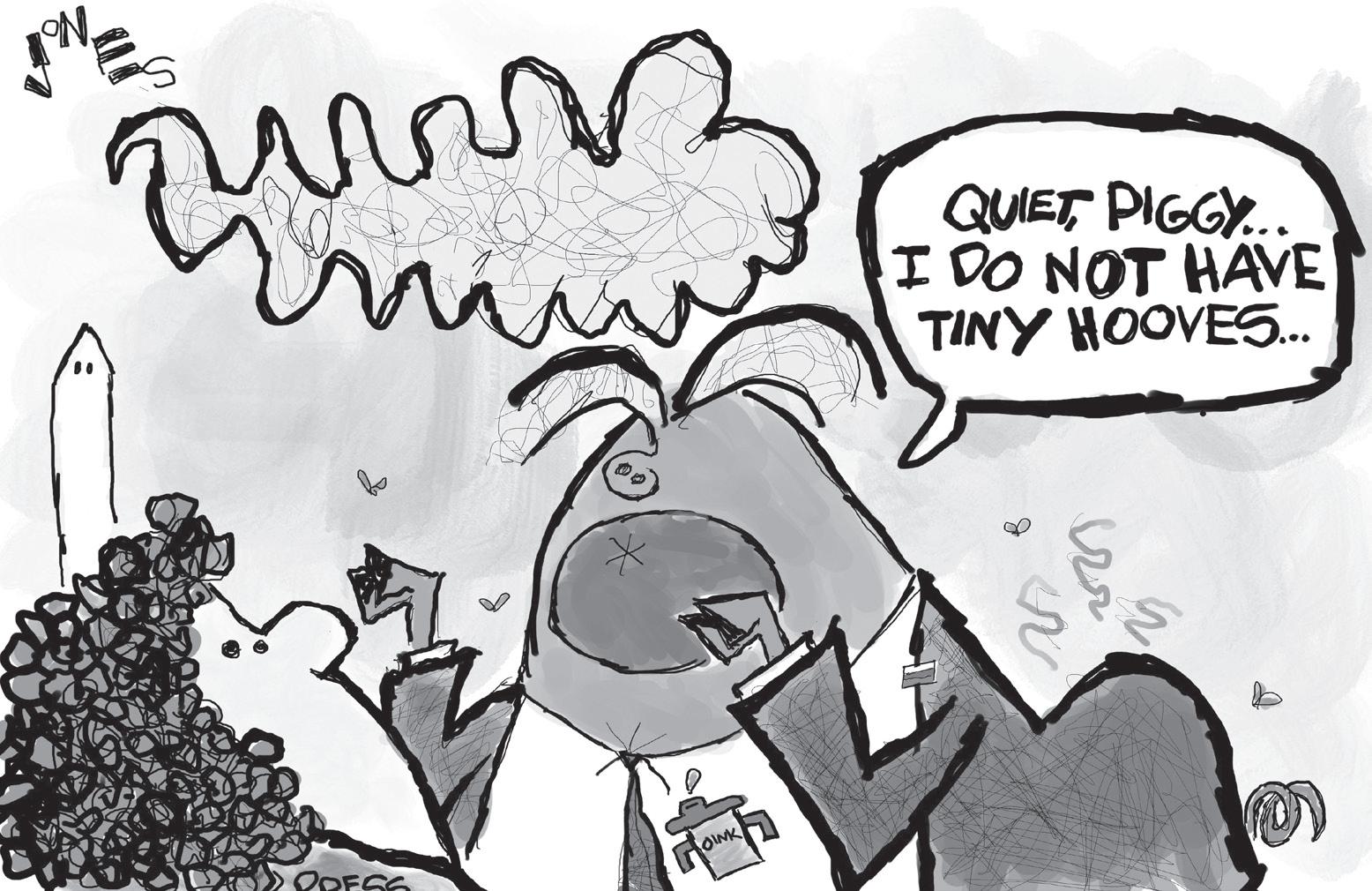
Please
IT Company seeks DevSecOps Engineer to integrate security practices into DevOps workflows, automate security checks, and ensure the safety of cloud infrastructure. Work closely with development and security teams to enhance the security posture of applications and systems. Build and Configure delivery environments by using CD/CI, Agile delivery methodologies. Create and assist in performing various types of tests. Perform troubleshooting. Generate customized reports. Offered Salary: $116,480.00 to $116,500.00/yr. Send resumes to: HRD, VITS Consulting Corp., 14264 23rd Ave N, Plymouth, MN 55447. Minnesota Spokesman-Recorder July 10, 2025
By Frances Murphy (Toni) Draper
On Nov. 14, 2025, aboard Air Force One, the President of the United States pointed at Bloomberg reporter Catherine Lucey and snapped, “Quiet. Quiet, piggy.” Why? She had the audacity to ask him a legitimate question about the Epstein files.
Days later, instead of apologizing, the White House defended him and implied that she somehow brought it on herself… That she was “inappropriate” and “unprofessional.”
By Nathaniel M. Fields
October is Domestic Violence Awareness Month, a time to honor survivors, remember those we have lost, and confront one of the most pervasive and deadly forms of violence in our society. Yet year after year, this month passes with too little outrage and too little action.
As a Black man and the CEO of the Urban Resource Institute, the largest provider of domestic violence shelter services in the United States, I feel a deep responsibility to speak plainly. Domestic violence is a shadow pandemic in America.
The video player is currently playing an ad. You can skip the ad in 5 sec with a mouse or keyboard
Every minute, 24 people experience physical, emotional, or psychological harm from an intimate partner. One in four women and one in seven men will endure this abuse in their lifetime. By the end of the day, three women would have been murdered by an intimate partner. For Black and brown women, the impact is far more devastating-both in scale and in severity.
Across the country, systemic inequities make safety, healing, and justice painfully out of reach. Black women represent only 14 percent of the U.S. population but account for 31 percent of intimate partner homicides. They are three and a half times more likely to be killed by a partner than white women and five times more
likely to die by firearm during pregnancy. Between 2010 and 2021, the number of Black women killed by guns tripled, with domestic violence driving much of that increase.
These are not just statistics, they are lives lost, families shattered, and communities left grieving in silence. And still, domestic violence remains one of the most underreported crimes in America. Too many survivors, especially women of color, stay silent out of fear, discrimination, or mistrust of systems that have too often failed to protect them.
The
For Black and brown women, those fears are magnified by economic abuse, the hidden weapon of control. Nearly every survivor experiences some form of financial coercion. Partners withhold money, destroy credit, sabotage jobs, and seize vital documents. When someone cannot open a bank account, work, or pay rent without permission, leaving is not a choice-it becomes a matter of survival.
We must face a hard truth: we cannot end domestic violence without addressing economic abuse and homelessness.
While the Violence Against Women Act in 1995 marked a turning point, our systems still

submissions@spokesman-recorder.com
submissions@spokesman-recorder.com
ads@spokesman-recorder.com
submissions@spokesman-recorder.com.
fall short. Survivors need more than shelter. They need economic independence, accountability for those who have caused harm, and prevention that begins early.
At the Urban Resource Institute, we meet survivors where they are. We provide safe, trauma-informed shelters for individuals, families, and even their pets because safety should never come with conditions. We equip survivors with job readiness, legal support, and financial tools to rebuild their lives with stability and dignity. We reach young peo-
So let’s be clear: Calling a woman “piggy” from the most powerful office in the world is abuse, not banter.
Suggesting she brought it on herself is classic abuser logic. And when the “CEO of the free world” behaves this way in front of cameras, he is not just expressing a personal opinion, he is modeling a pattern.
Verbal abuse and violence–What data actually shows: Public health and domestic-violence research has been warning us for years:
• The CDC identifies hostility toward women and attitudes that justify aggression as key risk factors for intimate partner violence.
PHON E: 612- 827- 4 021 FOR BILLING INQUIRIES
• CDC materials and other IPV research note that abuse often begins with emotional and psychological attacks: name-calling, humiliation, and verbal degradation, which can escalate over time into physical violence. Before the shove, there is the sneer. Before the bruise, there is the insult. Before the blow, there is the belittling.
And while October’s Domestic Violence Awareness Month has just passed, the deeper concern is not timing at all. It is the pattern. Rudeness is one thing; humiliation is another. What the president displayed is the same kind of demeaning, belittling language that experts warn often mirrors the early stages of emotional abuse. The fact that this happened so soon after a national month of education and awareness only sharpens the contrast between what we claim to value and what we tolerate from our highest office.
Suggesting
about domestic violence and then shrug when the president publicly body-shames a woman and blames her for it.
What we must do now.
This is the moment for all of us: parents, grandparents, teachers, pastors, coaches, mentors, journalists to:
• Name this behavior for what it is: abusive, demeaning, and dangerous.
• Teach our children explicitly that mocking someone’s body or humanity is never acceptable, no matter who does it.
• Model a different kind of strength; one rooted in respect, self-control, and courage, not cruelty.
• Speak up, publicly and privately, when leaders cross these lines. Not just when it’s politically convenient, but when it’s morally necessary.
Because if the president can call a woman “piggy” and blame her for it, and the country shrugs, then the problem is bigger than one man.
We owe women better. We owe our children better.We owe our democracy better.
We cannot claim to care
This commentary first appeared in The Afro-American Newspapers. It was edited for length but retains original language. For more information, visit www.afro.com.
ple through our Relationship Abuse Prevention Program, teaching what healthy relationships look like long before abuse begins. And through our Abusive Partner Intervention Program, we work directly with those who have caused harm to build accountability and change.
These programs work. They are changing lives every day. Yet too often, funding for prevention and intervention is seen as optional rather than essential. If we are serious about ending domestic violence, we must invest in solutions that address the full continuum-from emergency shelter to long-term stability, from survivor safety to offender countability.
The truth is, we all know someone who is experiencing domestic violence. By the time you finish reading this, three women will have been murdered by an intimate partner. But here is the hope: We have the knowledge, the tools, and the programs to stop it.
What we need now is the will.
We must raise awareness, remove stigma, and make resources visible and accessible. Policymakers must prioritize prevention and invest in grassroots organizations that meet survivors where they are. Communities must speak up, believe survivors, and hold abusers accountable.
This generation has the power to end the shadow pandemic. We can make safety, healing, and justice a reality for every survivor-if we act now.
Let’s get to work.
This commentary first appeared in Black Press USA. For more information, visit www. blackpressusa.com
By Hope Giselle-Godsey
Every year around this time, we gather in churches, community centers, and dimly lit rooms to read the names of people the world never cared to learn while they were alive. We cry, we hug, we hold each other up, and then most of us go home, and the world keeps spinning like it didn’t just take another one of us.
As a Black trans woman, I’ve stood in those spaces where the grief itself feels heavy. I’ve also been outside those spaces, watching people who need to be in the room choose not to show up. And I have to be honest: sometimes the Transgender Day of Remembrance (TDOR) feels like something we do for the moment, not for the movement. It has become an event you post about, instead of a call you answer.
So I keep coming back to the same question: What are we doing tomorrow?
TDOR wasn’t created for hashtags or polished graphics. It began as an act of defiance, a demand that the world stop ignoring our deaths. Yet somewhere along the way, our pain got softened, packaged, and made palatable. We read the names, but we rarely talk about why we keep adding new ones. We mourn the losses, but we don’t demand accountability for the systems and of the people responsible.
Grief is exhausting, yes. But we cannot simply remember; we must rebuild. We cannot just light candles; we must light fires under the systems that make our lives disposable. Because the violence against Black trans women is not random, it is cultural, po-
litical, and systemic. It thrives in silence, in what we refuse to name, in the spaces where our stories get edited out.
This year, I’ll be at the vigil. I’ll read the names. But I’ll still be asking: What are we doing tomorrow?
To answer that, I’m calling for something bigger than a ceremony. We need a Blueprint for Change, a living model that communities across the country can adapt not only to grieve trans lives, but to save them.
1. Build bridges between Black men and Black trans women. Our liberation is intertwined. We need intentional spaces for dialogue, barbershop conversations, healing circles, and community workshops. When Black men understand that protecting Black trans women strengthens the whole community, lives are saved.
3. Fund Black trans–led organizations year-round. Groups like The Mahogany Project, The Knights and Orchids Society, and Transinclusive Group provide housing, food, and crisis support on limited budgets. Consistent funding, not seasonal charity, keeps people alive.
4. Center local leaders in national conversations. Solutions are being built in places like Birmingham, Baltimore, and Baton Rouge. National outlets and organizations must uplift and replicate these local innovations.
2. Redefine safety through real accountability. Symbolic gestures from law enforcement aren’t enough. Cities must implement accountability systems led in partnership with Black trans advocates: annual bias and cultural-competence training, transparent incident reporting, community oversight boards, partnerships with trans-led groups, and accurate data collection. Safety requires consequences and transparency.
5. Make TDOR a call to action, not just mourning. Every TDOR should end with concrete next steps: volunteering, donating, attending town halls, or pressing law enforcement for accountability. If we embrace this blueprint, remembrance can become a revolution, a strategy for safety, healing, and survival. Because we don’t need another ceremony. We need a plan. This TDOR, when we say their names, let’s also say our commitments.
Let’s promise not only to mourn, but to act.
This commentary first appeared in Word in Black. It has been edited for length. For more information, visit www.wordinblack.com.
stopped after Washington read the screenplay.
However, getting MSU officials to finally release its findings from a fact-check and plagiarism review that they conducted has not been successful, said Washington.
“It is a complete mess that clearly the [MSU] leadership does not understand,” she reiterated. “The mess is big, it’s deep and it’s wide, and it’s bigger than me.”
More so, the Claerbaut book overshadows her own work. Maya’s father was among 20 Black players on the 1966 MSU football team coached by Daugherty and featured in her award-winning film, “Through the Banks of the Red Cedar” (2018) and her 2022 memoir, “Through the Banks of the Red Cedar: My Father and the Team that Changed the Game.”
Washington’s film currently is on PBS platforms, including PBS Documentaries Channel on Amazon Prime.
Furthermore, Maya strongly points out, it’s not just about her father.
“Whether that’s at Michigan State University or at other universities around the
country, that is not only concerning from my father’s generation and those who have passed on, but for young athletes who are not protected by the current NIL landscape, which is a decades’ worth of athletes whose name, image and likeness might exist in archives,” she stressed.
“There
are
other younger legacy players who have lawsuits related to NIL, and you’re going to see more of that.”
“Gene Washington, what he contributed to the institution in numerous ways while he was there [as a studentathlete in the 1960s], after he left — he’s a College Football Hall of Famer,” his daughter said proudly. “He had a successful NFL career, had a successful career in business, has been a very enthusiastic ambassador for the institution for over 60 years.
“If this can happen to him, you need to understand that there is a real potential that this can and will happen to other student athletes,” emphasized Washington. “No steps have been taken to sit down and unpack what happened, to actually sit down
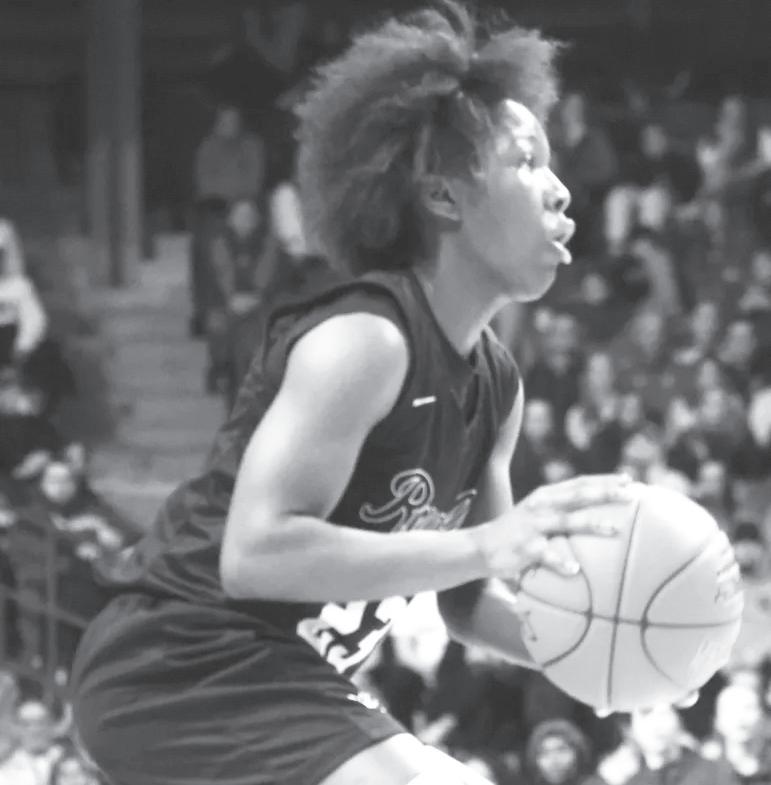
with my father and his team mates.
“That is an offer and a re quest that we’ve extended to Michigan State since 2022 … and they have declined our request that we’ve made and every offer in four years,” re ported Maya. “My dad is in his ‘80s. We’re trying to nip this in the bud.”
“There are other younger legacy players who have lawsuits related to NIL, and you’re going to see more of that,” said Washington. “You’re going to see more of that because institutions are sort of spinning their wheels trying to figure out [NIL] in this new climate.
“I think raising awareness about the need for legacy athletes to be vigilant when it comes to their NIL, to access their own sense of bound aries with the institution… What is the acceptable use of their name or their face?
“It’s really educating the general public,” concluded Washington, “but especially those who are sincere about their desire to preserve his tory or show respect or pay homage … The consequences of rewritten history isn’t just offensive but hurtful to the families who have to endure it.”
Charles Hallman welcomes reader comments to challman@ spokesman-recorder.com.
PREP
Continued from page 10




with 23 points. Cupito had 13, Davis added 12, Durant chipped in 11, and Walker 10. Walker and Diggs, both juniors, were brilliant as sophomores during the 2025 title run. Cupito missed the championship because of a knee injury.
The Lions, the top-rated Class 2A team, were led by Maddy Greenway’s 35 points.
Dr. Mitchell Palmer McDonald welcomes reader comments to mcdeezy05@gmail.com.






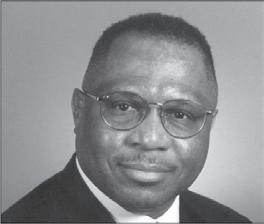
The pain and insult of rewritten history
By Charles Hallman Sports Columnist
aya Washington, an award-winning author and filmmaker, now is a strong NIL advocate for legacy athletes because of her family’s recent experiences.
Maya’s father is Hall of Famer Gene Washington, who played at Michigan State and in the NFL with the Minnesota Vikings, then established a successful career in corporate America. But the last
few years, she and her father have been fighting against a 2018 book by David Claerbaut, “Duffy Daugherty: A Man Ahead of His Time,” and a “Black Spartans” film project by his stepson based on the book. Washington said in our interview in last week’s MSR (“Michigan State’s ‘65,’66 Spartans subject of book/film controversy”) that both the book and the screenplay were full of errors. Eventually Michigan State stopped publishing the book, but not before copies were sold. The film was
■ See MAYA on page 9

Red Cedar”
courtesy of Running Water Entertainment LLC

irst-time author Dr. Gary F. Green provided advance copies of his new book, “Playing the Game,” to the three featured panelists at last week’s book launch and panel discussion at United Theological Seminary in St. Paul.
The book explores the longstanding myths and overused terms tagged on Black athletes. Each panelist as a result shared their thoughts on Green’s book during the one-hour event that Green moderated.
“You’re bringing us into this conversation and saying how we can have a critical lens of examination of the dehumanization and commodification of Black athletes,” said Dr. Lakisha R. Lockhart-Rusch, who appeared via Zoom. She teaches Christian education at Union Presbyterian Seminary, where she also is a womanist play facilitator.
At the start of the event, it was announced that Green has earned tenure as pastoral theology and social transformation associate professor at United.
Green briefly described for the audience his journey from being a Division I football player to now a professor: “When I was growing up, first of all, I wouldn’t think about

nobody’s academic anything. I was an athlete and I existed in a world where athletes were just beasts.”
Both he and Minnesota Vikings fullback CJ Ham discussed how the term “beast” used to describe how good a player is, but it also can have negative ramifications on Black players whenever used. Both said that perhaps the term should be permanently retired.
“For
“I think the term ‘beast’ truly just undermines what we do as athletes and undermines our brilliance,” said Ham, a starter with the Vikings since 2017 and a 2024 Walter Payton NFL Man of the Year nominee. “We’re talking about the
Families and coaching draw transfers to Tommies
irst-time St. Thomas
teammates Savannah McGowan and Jada Hood this season seem to be in an unofficial “arms” race for most tattoos on the team.
“We talk about it all the time that we want to go and get more tattoos together,” joked the 5’6” Hood from St. Paul.
“I got to thank the girls for just embracing me and my weirdness,” added the 6’2” McGowan from Plymouth.
Both confident Tommies took their own individual paths in their college basketball journeys before both becoming teammates this season.
Athena Award winner and four-time all-conference and all-stater at Robbinsdale Armstrong, where she scored over 1,000 points and grabbed over 1,000 rebounds, McGowan played at Illinois State for two seasons (2023-24, 2024-25) and appeared in 53 games. But she wanted to come home.
“I definitely miss being home,” admitted McGowan. Hood, a Roseville Area graduate, played three seasons at Kilgore (TX) College, then one season each at Texas A&M Commerce and at Memphis’ Christian Brothers University, where she led the team in scoring.
“It was really just trying to decide the last place I really wanted to end up at,” Hood pointed out.
“I really just wanted to be a part of a program where I felt I could trust my coaches … I wanted to be a part of a program where I knew I was going to be loved.”
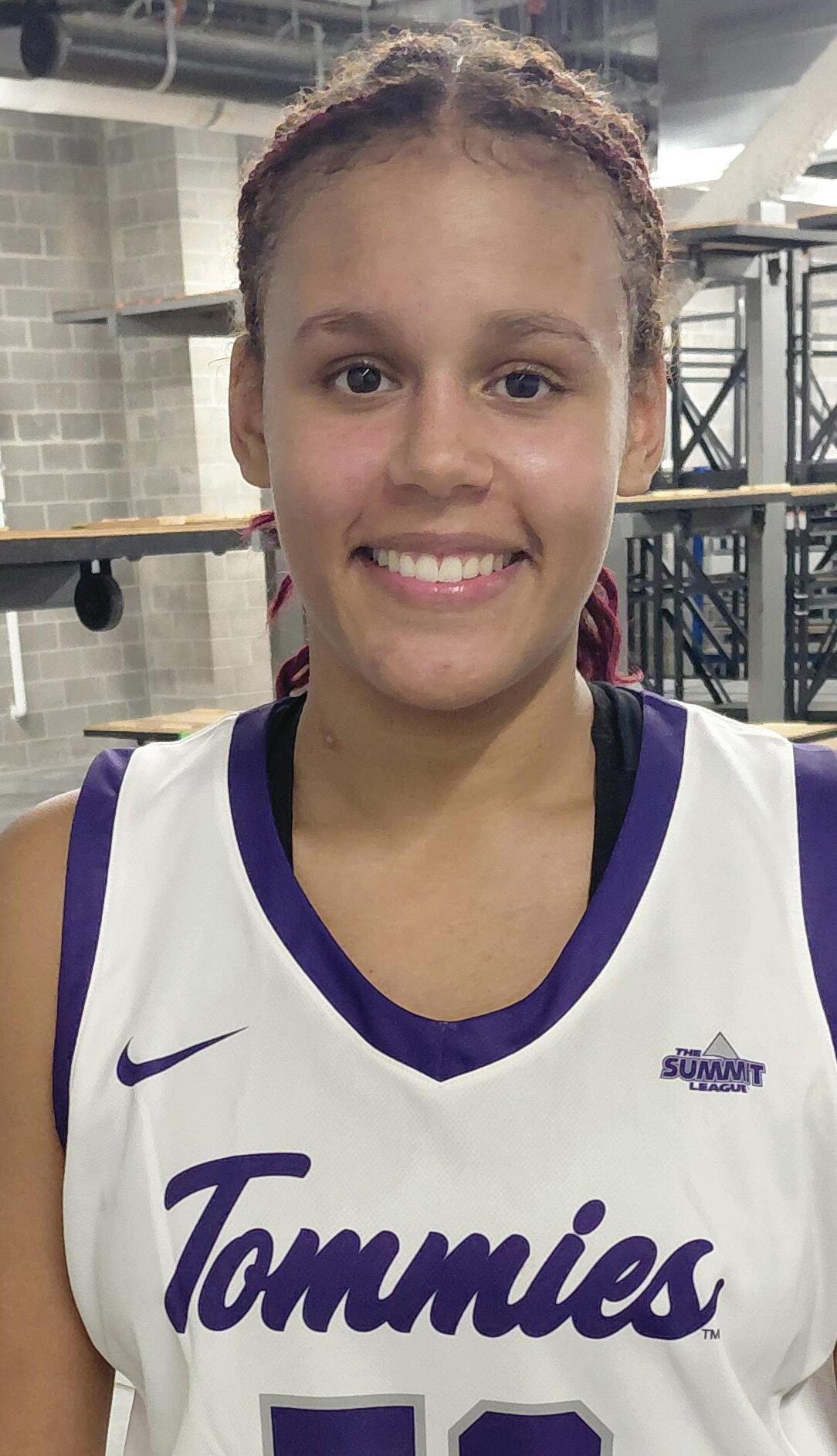
Both she and McGowan are now playing for the coach that first recruited them in high school, St. Thomas HC Ruth Sinn.
“I wanted to be a part of a program where I knew I was going to be loved.”
“She [Sinn] immediately called me and said, ‘When can you come for a visit?’ I said yesterday,” said the guard, smiling. Added McGowan of Sinn,
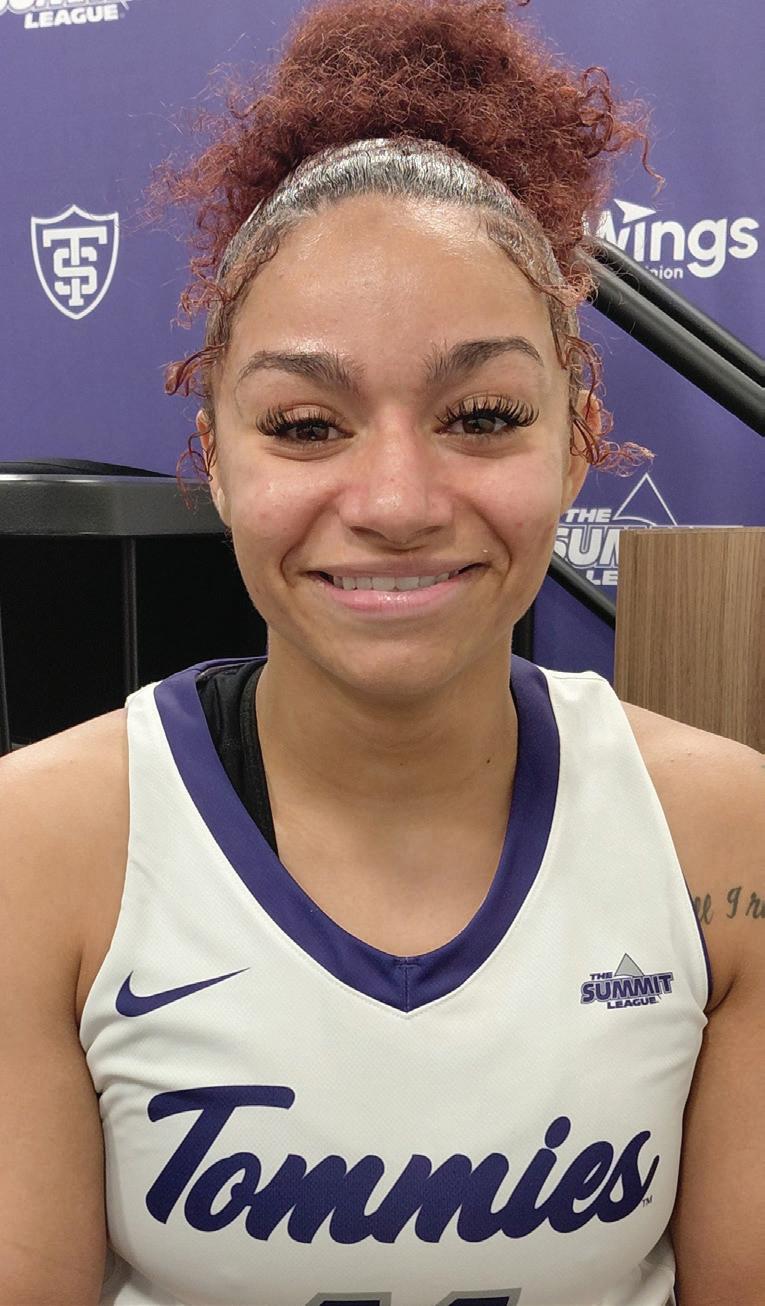
“She is one of the few coaches in my life who truly understands me, gets my frustrations, knows how to calm me down, gets my energy, all my weirdness.”
The new Tommies both are starters this season, Hood at point guard and McGowan down low.
“Coach said she had all the belief in me, and it’s been like that since day one,” continued McGowan. “I wanted to show the world that I can play.”
“It’s just really exciting to be in a place where I can grow,” added Hood. Also, it can’t be understated how important it is for both former local prep players to
play in front of family, friends and others at home games.
“I love my family,” said Hood.
“It means a lot to me that I can be a part of my family.”
“My parents are my biggest support system,” stressed McGowan. “I would see them twice, maybe three times a year at Illinois State. It was hard seeing everybody else’s parents be there. I was like, ‘Damn, I wish I could give my mom a hug. I wish I could give my dad a hug.”
With her criminal justice degree, Hood is now studying for a master’s certificate in data analytics. “I decided to get into that because I want to ■ See SOE on page 9
hours spent in the gym, doing film study, just training our bodies to be able to react and perform in an extraordinary way.”
Ham also pointed out how too often Black and white athletes are selectively described by media, fans and others — the former has God-given skills, but the latter is smart and works hard to be the player they became. He asked why it can’t be both.
said United student Tamice Spencer-Helms, who also is a school admissions counselor.
“So it would be too Black in white spaces but too gay in Black spaces, and so really feeling that there was not a path for me.”
She said the book opened her eyes, especially in reaffirming how society labels are hurtful and lasting.
Lockhart-Ruschthen told the audience that “Playing the Game” “definitely expands the conversations as we think about play.”
On Green’s book, “For me, being Black and queer is kind of a triple consequence,”
“When you talk about the contrast between the way Black athletes and white athletes are talked about … if you listen to [former NFL star QB now commentator] Tom Brady talk about the game of football,” continued Green, “[he] will regularly talk about how the game is dumbed down, the quarterback [position] has become dumbed down.
“Tom Brady talks about … a game where you got more Black quarterbacks playing
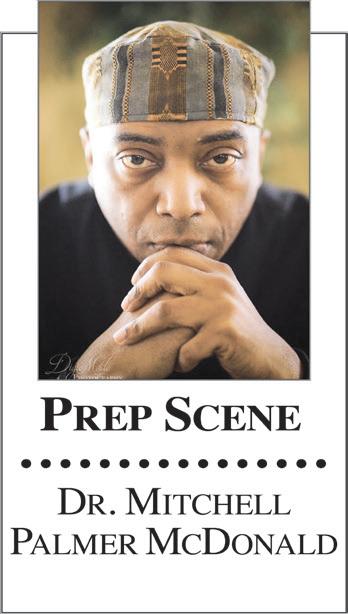
hen former
neapolis North
basketball player and Hopkins assistant coach Tara Starks was named head coach of the Royal in 2020, she was quoted by a media outlet as saying, “I just want to get into the gym.”
Well, ever since getting into the gym, Starks has maintained the program she helped build as an assistant to Brian Kosgriff while putting her own stamp on the team as head coach. Since she’s taken
